






Scale of 7,300+ sites and growing


Dedicated in-country teams
End to end service: mastering, distribution, keys
In-market hard drive backup for zero dark screens
I’ll be back”, was the promise we made when the pandemic hit. It’s been a few very hard years and to many it felt like it might never happen, but thanks to the perseverance of everyone in the industry, some incredible content and the faith of movie-goers around the world, it feels as though we’re finally back, reflected in the positive mood surrounding CinemaCon.
And with positivity and the famous movie line ringing in our ears we present to you all the CineEurope edition of Cinema Technology Magazine with a focus on Artificial Intelligence.

Automatonophobics (I had to look that up!) and Robophobics amongst you might want to hide behind the sofa as we take a look at what the future might look like. It’s perhaps more or less grizzly depending on your perspective but one thing is for sure, we cannot ignore it. Our writing team have done a great job
exploring the topic and providing you with a balanced view about the positives, the negatives and indeed the potential that may exist in the future. Of course, AI presents interesting opportunities, things that may undoubtedly make our industry smarter, however there’s no valid substitute (at least not yet) for the creativity, artistry and humanity that makes our industry what it is.
Speaking of humanity, the entire CT Magazine and CTC team would like to extend a hearty congratulations to the wonderful Helen Budge and her husband James on the recent arrival of their baby girl!

In the March edition we promised that our focus on sustainability would become a regular topic that we would return to, so amongst the articles in this edition we spotlight the fascinating concept of low-carbon modular cinemas for rural communities being prototyped in the UK. We also look at the benefits of satellite delivery which of course can play a part in reducing the carbon
footprint of content. There’s also a plethora of other fascinating content provided by our fantastic team of writers. Finally, with all eyes turning towards Barcelona and CineEurope, the CTC and CTM team will be there in force, so please make sure you say hello by visiting our trade show booth! And as always, if you know of any interesting stories for future editions, do get in touch with our Commissioning Editor, Peter Knight, and we’d be delighted to cover them: peter.knight@cinematechnology.com.
Richard Richard Mitchell, President, Cinema Technology Community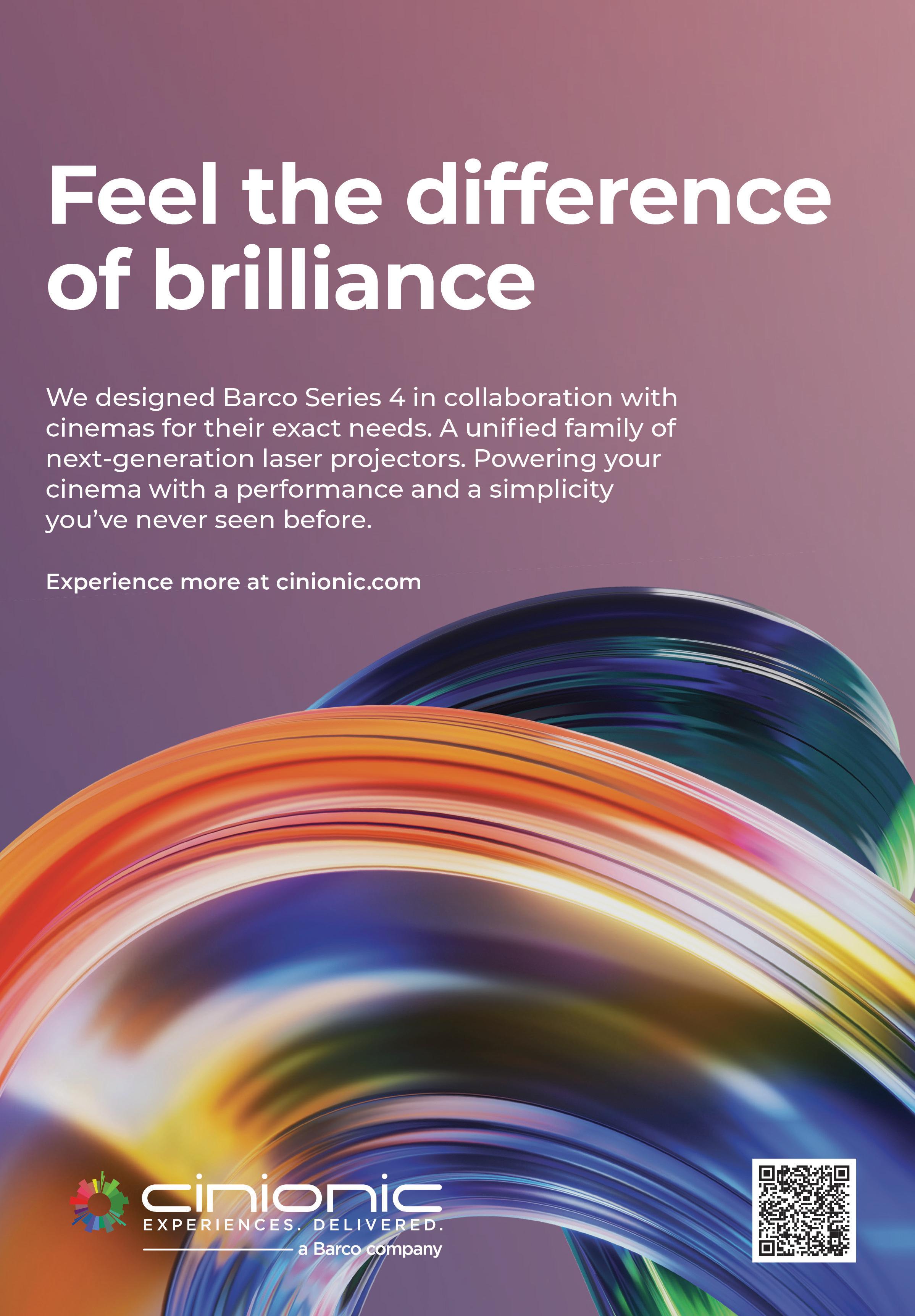
RICHARD MITCHELL E: richard.mitchell@cinema-technology.com
We catch up with Dolby for an update on their technology developments. 38
Lucy Jones provides us with an update on Box office trends.
We look at the benefits of satellite delivery for content.
46
How pre-built modular low carbon cinemas might be the future for rural communities.
51
D-BOX celebrate their 25th anniversary. We look at a quarter of a century of success.
56 We interview GDC's Dr Man-Nang Chong to find out about the GDC scholarship programme.

Sandie Caffelle talks to Laura Fumagalli and learns about Italian exhibition trailblazers Arcadia Group.
58
ART DIRECTOR: DEAN CHILLMAID
E: dean.chillmaid@cinema-technology.com
COMMISSIONING EDITOR: PETER KNIGHT

E: peter.knight@cinema-technology.com
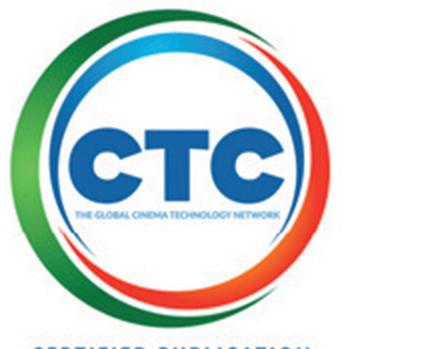
ADVERTISING: ADVERTISING TEAM
E: magazine.advertising@ cinema-technology.com
SUBSCRIPTIONS
Cinema Technology is mailed to IMIS Members. For subscription details and to read the magazine online, visit www.cinematechnology.com or email peter. knight@cinema-technology.com


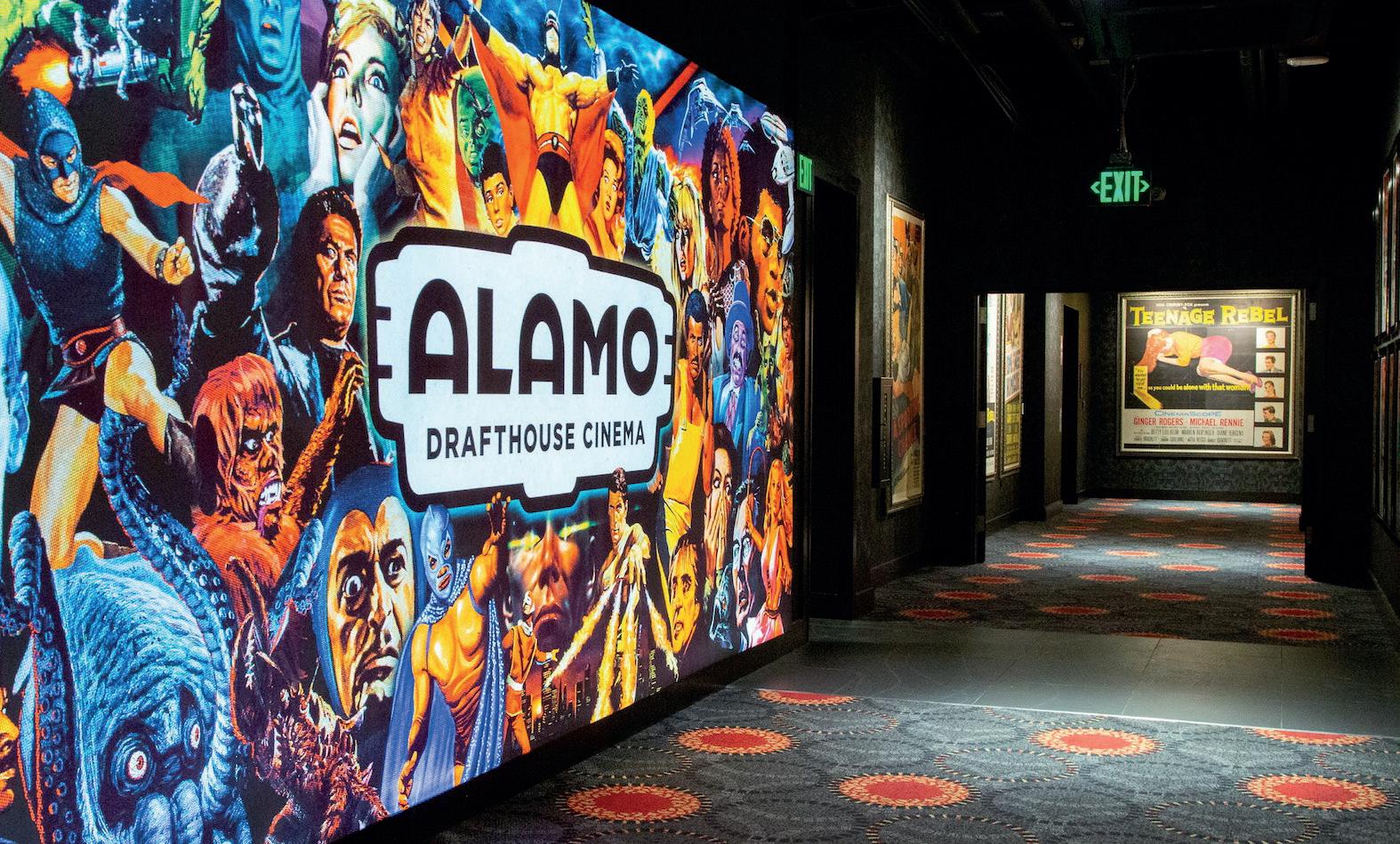
Arts A lliance M edia & Sound Vision Technical Announce screenwriter partnership with Alamo Drafthouse Cinema
ARTS Alliance Media (AAM), the global leader in digital cinema software and support, and Sound Vision Technical (SVT), a technology services provider offering digital cinema conversions and installations worldwide, has announced a new Screenwriter partnership with Alamo Drafthouse Cinema, a leading cinema chain in the United States. Upgrading their network’s content management solution to AAM’s Screenwriter Theatre Management System (TMS), Alamo Drafthouse will centralise each site’s operations to gain comprehensive control over
all screens, content and KDMs. The transition will enable Screenwriter to power 345 screens throughout the United States including all franchise locations.
“We’re delighted to work hand-in-hand with AAM and SVT on our new, circuit-wide technology rollout”, explained Frankie Vaquerano, Director of Presentation at Alamo Drafthouse. “Installing the Screenwriter TMS will empower our team to automate many essential practices and refine the digital operations of each of our esteemed locations”.
CINEMATRONIX and Danny Pickett announced the acquisition of Bay Area Cinema Products (BACP) of California and Washington. Kevin DeRijck and Danny Pickett, principal officers, will provide sales and service domestically and internationally as they are committed to providing the best cinema equipment, service, and presentation in the business. Sam Chavez, President of
BACP, - who served 15 years with Dolby Laboratories, before starting BACP - states, "I couldn't be prouder to have Cinematronix and Danny Pickett carry on Bay Area Cinema Products 20-plus year legacy.” Kevin Eagle founded Cinematronix in 1991 after being encouraged to do so by Chavez, and today it is Canada’s largest & preeminent dealer of commercial projection & sound equipment.
DIGITAL Cinema Distribution Coalition (DCDC), the world’s largest cinema satellite delivery network, has partnered with CineSend and Velocity to provide a terrestrial broadband solution to the US cinema industry. Since their inception, DCDC has provided the industry with a cost effective and efficient form of digital delivery to cinemas across the country, now reaching more than 33,300 screens. Of DCDC’s 3,120 theater sites, 130 are “satellite challenged” and cannot receive satellite deliveries due to line-of-sight issues. These cinemas have been receiving content via physical hard drives. To expand their reach and enable these sites to receive content digitally, DCDC has selected CineSend to provide their hardware and software solution for the Network and Velocity, A Managed Solutions Company (Velocity MSC) to install broadband connectivity.
CineSend designed, built and operates Canada’s largest terrestrial broadband digital cinema delivery network for feature film. Its platform transmits thousands of titles to hundreds of film festivals around the world including Sundance, Tribeca, and NYFF. Cinesend’s OTT solution powers online streaming experiences racking up millions of views across studios and cinemas including A24’s Screening Room, Metrograph At Home, and other leading media and entertainment brands. Velocity MSC is a leading provider of technology solutions voice and data networking and connectivity for multi-location enterprises, along with digital media displays and advertising networks. Velocity has been working in the cinema exhibition space for many years and has a partnership with ScreenVision Media, among others.
ARTS Alliance Media (AAM), has confirmed that Screenlighter, the new Theatre Management System (TMS) designed exclusively for small and independent cinemas, is now available for deployment after installations across the USA.. After announcing their intention to release a compact version of Screenwriter in October 2022, Screenlighter, a solution designed to solely meet the operational requirements of independent and 1-4 screen cinemas, is now market-ready and
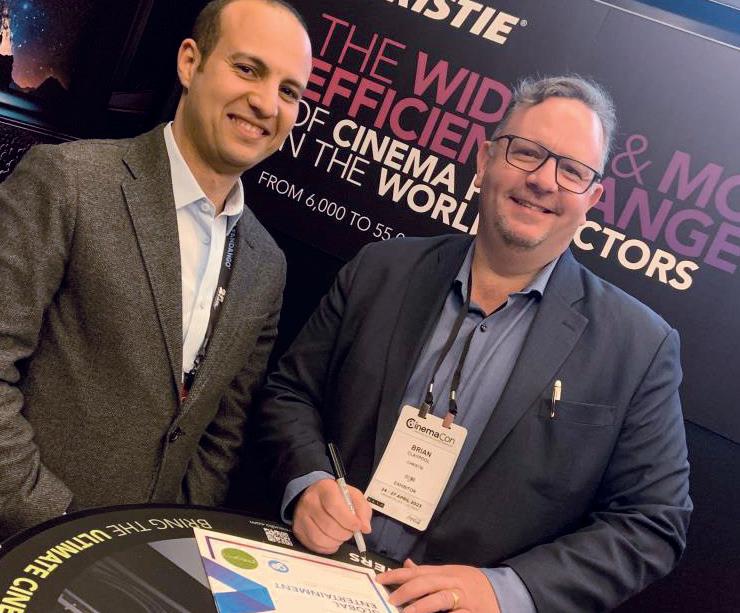
CHRISTIE recently announced that its projectors will be installed at several hundred screens across Morocco as part of a brace of projects carried out by partner Global Entertainment. The government-backed SIN project will see more than 100 screens adorned with Christie projection at cultural centres across the country, on behalf of the Moroccan Ministry of Culture and Communications. A second project will also see more than 100 Christie projectors installed at Cinerji, a new exhibitor, in sites across Morocco.
“Both projects reflect our commitment to providing high-quality and accessible cinema experiences to communities across the region, with a significant cultural impact,” says Hakim Chagraoui, founder and CEO of Global Entertainment. “The cinema culture in Morocco is rich and diverse, with a long history of film production and consumption. The country also has a strong appetite for international films
and cinema-going is a popular social activity, particularly among younger generations. We chose Christie solutions for our cinema project due to their reputation for quality and reliability, which are what we were looking for to offer the best experience to our customers. The equipment has met and exceeded our expectations, and we would highly recommend Christie solutions.”
Cinerji is set to open its screens at 25 multiplexes in large and medium-sized cities of Morocco, while the SIN project will see screens added all across the country’s government-owned cultural buildings The SIN Project is aimed to be completed by the end of 2023, and the Cinerji rollout is estimated to be completed in three years. Cinerji cinemas will also feature Christie Vive Audio® sound systems. Both projects aim to create a sustainable business model by balancing a premium experience while maintaining affordable prices for cinemagoers.
successfully being operated following the completion of a robust pilot program.
“Last year, we outlined a vision to support exhibition by catering to the needs of cinemas of all sizes. Today, we deliver on that vision”, announced David Ong, Chief Commercial Officer at Arts Alliance Media. “Screenlighter provides 1-4 screen exhibitors with a trusted and affordable TMS, and we’re ready to work with our network of integrators to support its deployment.”
Facilitating playlist creation, on-screen content control, reporting, and real-time site monitoring, Screenlighter enables cinemas to evolve from manual operations to centralised screen, content and KDM management. With intuitive navigation, drag-and-drop playlist creation, and a light-mode UI that offers clear distinction from existing entry-level TMS solutions, exhibitors can embrace a refreshing and effortless software experience.

–
AT Cinemacon, GDC Technology confirmed that they would be CJ CGV Cinemas exclusive provider from 2023 to 2026. The agreement involves the deployment in China, South Korea, and Southeast Asia of the SR-1000 media servers with a built-in cinema audio processor for 7.1 surround sound and Enterprise Storage. The agreement covers the replacement of legacy media servers at CJ CGV existing sites and all their
CineEurope announces its 2023 Gold Award
Recipients:
RON STERK
VUE NEDERLAND
JAVIER HOYOS
ODEON CINEMAS GROUP
JAN RASMUSSEN
NORDISK FILM CINEMAS
KELLY DREW
CINEWORLD GROUP
KADRI KALDMA
APOLLO CINEMA
TÕNIS KÜMNIK
CINAMON GROUP
MAX BELL
BELL THEATRE SERVICES
The BCTV, is a charity for people who have been in the industry for 30 years or more. Benefits include The Veteran magazine, invites to events with fellow members, usually subsidised, and for Cinema members only, a free cinema pass for the member and a guest at the following cinemas:-, Cineworld: Everyman: The Light: Odeon: Picturehouse: Showcase and Vue.
www.britishcinemaand televisionveterans.org.uk
new construction projects. CJ CGV will install up to 1,000 units during the agreement’s four-year period. To date, GDC media servers has the largest market share in the whole of Asia Pacific including top market share in China, Japan and Korea. GDC media server is also leading the replacement market in North America. CJ CGV is the largest multiplex cinema chain in South Korea and has cinema complexes in China, Indonesia, Myanmar,
Turkey, Vietnam, and the United States. CJ CGV is the fifth-largest theatrical exhibition company in the world. CJ CGV currently operates 4,207 screens at 591 locations in seven countries, including 1,343 screens at 191 locations in South Korea. CJ CGV opened the first multiplex in Gangbyeon in 1998. In December 2004, it became the first theatre chain listed on the Korean Stock Exchange.
VISTA Group announced a further commitment to its platform, with the signing of an agreement to transition existing client and leading UK independent cinema group, Everyman Media Group PLC.
Operating over 130 screens currently, Everyman has continued to expand its circuit across the UK, announcing that it would open new cinemas this year, taking the company to a total of 43 venues in 2023. Positioned at the premium end of the UK cinema market, Everyman features high quality, unique venues in central high street locations.
The agreement with Everyman includes Vista Group’s full cloud platform: Vista Digital, the platform that supports innovative digital experiences; Vista Cloud, powering all cinema operations and circuit management; and Movio Cinema EQ, a dynamic solution that improves how cinemas market movies to moviegoers with a focus on increasing connection, attendance and spend. Everyman will transition its circuit from Vista Cinema’s on-premise software to the platform over the course of 2023.
Vista Cloud combines decades of industry expertise, a commitment to constant innovation, and the benefits of SaaS. The technology focuses on solving clients’ biggest challenges and
reducing cinema teams’ operational workload.
“Everyman is a longstanding client and one of the most innovative cinema circuits in the UK. We are delighted to be able to work with the team at Everyman to deliver the most exciting cinema experience for its moviegoers and optimise cinema performance by leveraging Vista Group’s global leading software and data solutions,” said Stuart Dickinson, Vista Group CEO.
“Our platform is transforming cinema operations for our exhibitor clients, from simple and serverless innovation with Vista Cloud, to rich digital experiences for moviegoers with Vista Digital and smarter, data driven marketing solutions with Movio Cinema EQ. We’re excited to see Everyman embrace the vast benefits our technology brings.”
Colin Kendrick, Everyman’s Head of IT said: “Our focus is on delivering moviegoers the highest-quality experience and as a leader in cinema, innovation is and always will be essential to us. We’re excited to take advantage of the innovation that Vista Group’s SaaS platform will deliver, and we look forward to the solutions supporting our mission to create an exceptional cinema experience for our customers.”
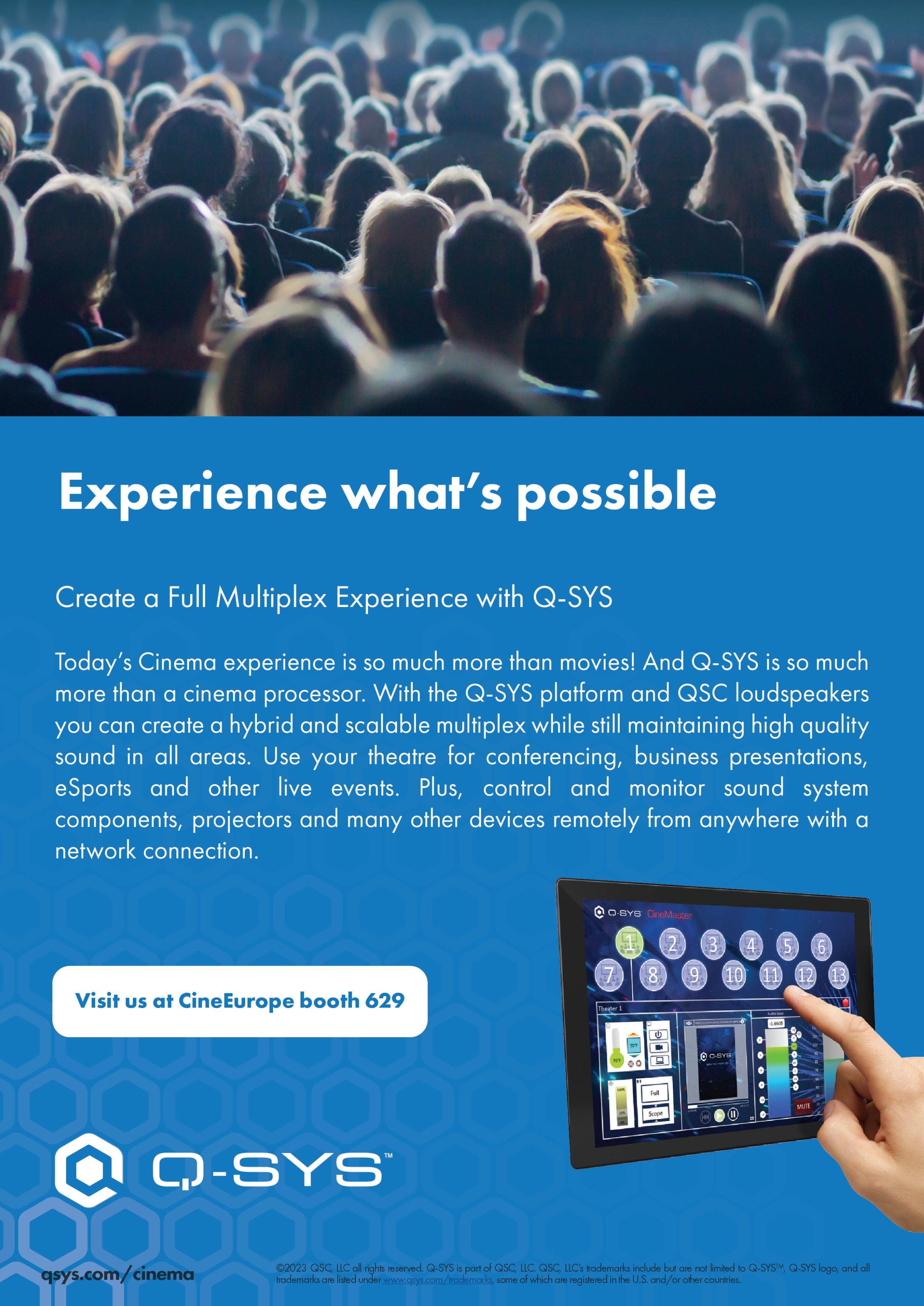
AMC Theatres® (NYSE: AMC and APE), the largest theatrical exhibitor in the United States and the world, announced plans to bring Laser Projection by Cinionic to its premium large format brand, PRIME at AMC®. The initiative, which is set to begin later this year, brings nextgeneration laser technology from the leader in laser cinema, Cinionic, to all PRIME at AMC locations throughout the United States.
PRIME at AMC is AMC’s native PLF brand and combines immersive sound, luxury seating, and large format presentation. Laser Projection by Cinionic elevates the premium cinema experience for audiences. Upon completion of installation of Laser Projection by Cinionic, the PRIME at AMC auditoriums will feature high contrast Barco 4K laser projection, delivering brighter and more vivid onscreen images that stay consistent over time.
“As we continue to install Laser at AMC, powered by Cinionic, in our theatres around the United States, we’re
pleased to now include our native PLF, PRIME at AMC, under our partnership with Cinionic,” said Cynthia Pierce, AMC Theatres Senior Vice President, Design & Construction, Facilities, Sight and Sound. “The addition of Laser Projection by Cinionic to PRIME at AMC is another guest benefit to an already popular Premium Large Format experience.”
The introduction of laser in PRIME at AMC auditoriums continues the company’s dedication to Make Movies Better and commitment to the future of cinema. Laser projection offers a more environmentally friendly way to present movies with less waste, including the elimination of replacing xenon bulbs, and a significant reduction in energy usage. The PRIME at AMC upgrade project is the latest development in AMC’s partnership with Cinionic which began in 2022 with Laser at AMC. Since first introducing laser cinema technology nearly 10 years ago, Cinionic is the industry leader today, powering over 35,000 screens around the world with Laser Projection by Cinionic.
CINIONIC and CJ 4DPLEX, the world’s leading producer of premium film formats, announced a new partnership to power the global ScreenX format with Barco laser projection. The deal names Cinionic as the global laser projection partner for ScreenX, covering future ScreenX installs and renewals of older sites. With this announcement, CJ 4DPLEX’s ScreenX joins the growing number of premium cinema brands turning to Cinionic to power their premium experience with the leading laser technologies.
This is an exciting time for ScreenX and Laser Projection by Cinionic as each continue
to grow rapidly. Now more than ever before, audiences are looking for high-quality, differentiated ways to go to the movies, accelerating the interest in laser-powered premium cinema experience.
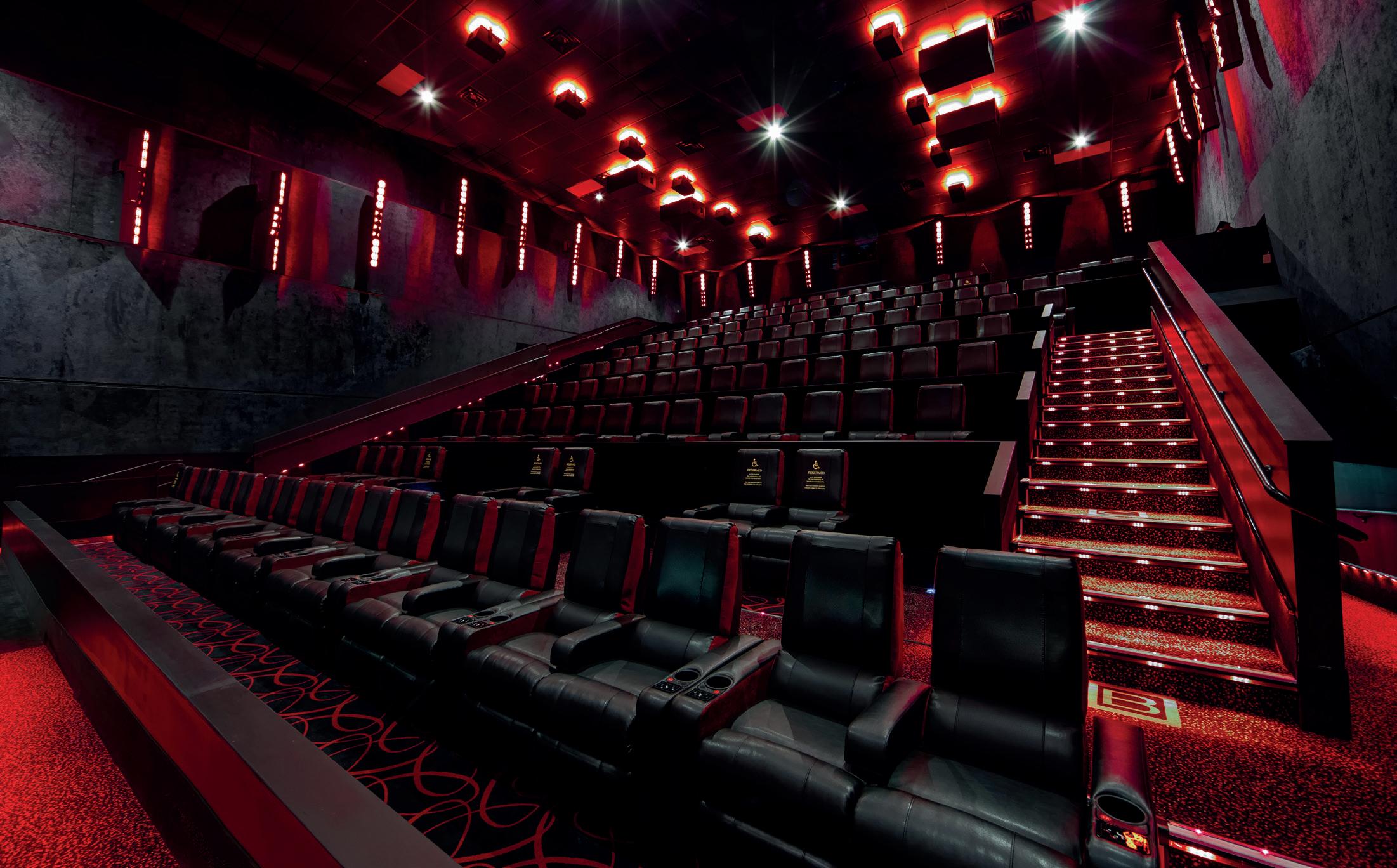
“This is another milestone for both companies as the footprints of ScreenX and Cinionic expand,” said Jong Ryul Kim, Chief Executive Officer of CJ 4DPLEX. “With the integration of upscaled ScreenX technology, featuring a seamless screen and Barco projection, we are confident that this collaboration will provide our audiences unparalleled satisfaction.”
Cinionic’s solution for CJ 4DPLEX leverages Barco laser projection commonly deployed at large-scale installations and projection-mapped immersive experiences and will be used to offer a consistent and bright image for the side-wall illumination in ScreenX’s unique format. With Cinionic, the power of ScreenX can be delivered using a single projector for each side wall, generating better image quality for moviegoers without the hassle of the multi-projector systems of the past, while also reducing the operational support & maintenance at each ScreenX location.
KINEPOLIS and IMAX Corporation announced a global expansion of their longstanding partnership with eight state-of-the-art IMAX with Laser systems across Europe, Canada and the U.S. The agreement includes four new locations across Europe — including France, Belgium, Spain, and the first-ever IMAX system in Luxembourg — as well as a new location in Michigan and Ontario and two upgraded systems in Ontario.
The announcement was made during the 2023 Cannes Film Festival.
The new agreement nearly doubles IMAX’s footprint with the Belgiumbased international exhibitor and its subsidiaries, including a first-time collaboration with MJR Cinemas, a U.S. subsidiary of Kinepolis. At present, IMAX partners with Kinepolis and its subsidiaries on seven locations currently in operation across Belgium and Canada. Under the agreement, IMAX will enter new territories with Kinepolis in Canada, Belgium, France and Spain, and Luxembourg.
UNIQUEX'S new version of the feature-rich TMS now includes an array of autonomous power management tools to reduce cinemas’ energy consumption. Utilising intelligent integration logic, RosettaBridge Eco TMS can control every device in a theatre, while maintaining full operational automation and superior customer experience. From controlling start and end of day programmes based on scheduling data, to automatically turning on and off all projection, sound, HVAC, lighting and other critical systems, cinema operators can vastly reduce their daily kilowatt consumption. Through the Cinema Zones functionality, any custom room or part of the cinema can be included, while devices are added and controlled through integrated power distribution units that manage everything from projectors to lobby screens.

It has been the stuff of fiction in movies since the very beginning of the industry, but now it is beginning to become a very real reality. One of the many purposes of CT is to give industry members a look at new technology that is about to enter the world and think about its uses within cinema. Previously, CT has looked at 5G and holographic projection to name two future technologies, so now that artificial intelligence (AI) is just beginning to really move from laboratories to the real world, it is only right that it makes an appearance in our pages.
It would be highly unlikely if you did not see any articles about artificial intelligence (AI) in the last six to twelve months, as it seems that the technology has finally started coming to the fore after decades of being more theoretical than possible. The number of column inches and radio or television news segments on the topic seems to be increasing on a daily basis.
We are right on the edge of this new era, in much the same
way we had an industrial revolution, an information revolution, and a data revolution. Now we are on the cusp of an AI revolution, with a number of countries and organisations vying for their place at the forefront.


The excitement over AI is well-founded; the technology has the potential to transform many industries and create new ones. It can enable us to do more with less effort, freeing up human brains for more interesting and complex tasks. AI can also help us make better decisions and solve problems faster than ever before, as well as aid in the diagnosis and treatment of diseases.
But how we use this technology is just as important as its potential applications. We must think carefully about the implications of our actions—both good and bad—when it comes to artificial intelligence and ensure that we are making ethical decisions as well. Currently, much of the mainstream news stories are around the negative elements and who is going to regulate
A look at artificial intelligence and how it might impact the cinema industry.
and control the technology along with the many ethical questions that it brings up - and this does not include copyright and ownership challenges as well. Like any new mass technology that comes along, there is going to be an impact on our daily lives. That has probably already started, but we may not know it yet. Some of the impacts will be beneficial and positive, but like all new developments, there will be negatives, with job losses being one possible effect. But the development of AI is probably one of the largest changes that we are ever going to experience in history, and that includes things like the industrial revolution.
What nobody knows is exactly what this may be, and like many articles that have already been written on the topic, this is one that we can only really speculate as to what this may mean in the cinema exhibition industry. Equally, whether AI is a benefit or a danger will depend on a number of different factors. Simple AI implementations have started to appear in a number of software tool sets across the cinema industry over the last few years. They are often just new tools that are provided as feature enhancements, but in the background, they are making use of the features of AI.
And because AI heavily relies on machine learning and data sets, it is possible to add another layer of intelligence to the big data that was the buzzword of half a decade ago. Of course, if you have a smart speaker such as Alexa, Google or SIRI then you have been interacting with an AI, be it a not-too-intelligent one - many of the responses are pre-programmed and currently have no real way of ‘thinking; or improving for themselves. But it is only a matter of a short time before we are likely to have more self-aware ‘smart’ devices in our homes.
With some of the many tools that have been developed and released across the internet, it is now possible to make use of AI tools in a whole variety of different ways and tasks. One of the biggest developments is around copywriting. Did you notice the article in CT that was written by an AI? If you did not have a look at First Steps into the World of Artificial Intelligence on page 16 which was entirely written by the OpenAI ChatGPT AI - it needed the appropriate prompts in much the same way that any other piece of content is commissioned, and was also edited in the same way that any other article is, but the many paragraphs and sentences of the article were created by the AI. This article was written before Microsoft paid to integrate ChatGPT into its Bing search interface. Currently, tools like CopyAI and Jasper are AI tools that can help to provide ideas and suggestions while writing as an additional tool, just as you might use a spell checker over a dictionary. Elsewhere in this edition, we have also highlighted some of the AI tools that are available to you across the internet.
There are many well-known software applications within our exhibition industry that are already using AI tools to provide additional means, such as the recently launched EQ from Vista Group Company, Movio. When Movio released the new product in 2022 it included an email marketing tool that helps draft content for the user through the use of AI.


Like any new technology, there will be many who worry about the increased use of automation and machines within the industry, but like any technology AI is just a tool, it may be a powerful tool, but a tool nonetheless. It is there to help you, and at the time of writing, AI still needs human prompts in order to give it some direction. Cinema even with an abundance of AI is still a very human industry and still going to rely on people to make it happen, AI just creates new tools and potentially new opportunities.
You can be sure that this is just the beginning of this topic within the pages of Cinema Technology Magazine and that we will be including further articles and stories as this technology continues to develop and makes its way into our everyday lives, in whatever form that may take. Of course, if you are looking back at this article in 2030 - yes it was written by a human and not by a machine!
he concept of “artificial intelligence” (AI) can be perplexing. Artificial intelligence (AI) is the ability of a machine or computer system to perform tasks that normally require human intelligence, such as language comprehension, pattern recognition, and learning from experience (AI). Machine learning algorithms are one popular method, but there are many others.Machine learning algorithms are computer programmes that learn and improve their performance on a specific task over time without being explicitly programmed to do so. Based on data, these algorithms can learn to recognise patterns, make predictions, and take action. By analysing a large dataset of images of, for example, animals, a machine learning algorithm can be trained to distinguish between species. Once trained, the algorithm can be used to recognise animals in photos it has never seen before. Machine learning algorithms require a large amount of training data and run on specialised computer hardware known as a “neural network” to learn. Designing and


Artificial intelligence (AI) has been around since the 1950s, when scientists first considered creating machines with human-level intelligence. The man who coined the term, John McCarthy, proposed one of the earliest definitions of AI, describing it as “the science and engineering of making intelligent machines.”
Natural language processing, machine learning, and robotics are just a few of the fields where AI research has advanced significantly in the decades since. Significant milestones in the evolution of AI include:

The term “artificial intelligence” was coined in 1956 at a conference held at Dartmouth College.
LISP, the first artificial intelligence language, created in 1966. In 1971, IBM developed the first artificial intelligence (AI) chess programme.
Shakey, the first mobile robot, was created in 1974 by scientists at SRI International.
Japan began work on the Fifth Generation Computer Systems
training an effective machine learning algorithm is a timeconsuming process that requires expertise in math, computer science, and statistics. As a result, while AI and machine learning algorithms have the potential to automate and improve the
efficiency of many tasks, they also raise significant ethical and societal concerns about the roles of humans and machines in our society.
project in 1980 with the goal of creating a machine with human-level cognitive abilities.
Deep Blue, an IBM computer, defeated world chess champion Garry Kasparov in 1997.
Watson, created by IBM, won Jeopardy! in 2011. In 2014, a deep neural network-trained algorithm won the ImageNet challenge, catapulting deep learning to the forefront of the machine learning community.
AI is now used in a wide range of contexts, including, but not limited to, speech and facial recognition, language translation and decision making. There is also ongoing research into its potential applications in autonomous vehicles, robotics, and medicine.


CT explores this growing area, which has been around for a while but is only now beginning to permeate our daily lives.
When it comes to quickly analysing large datasets and making predictions or decisions, artificial intelligence more often than not outperforms humans. In the medical field, for example, AI can assist doctors in making more precise diagnoses, in agriculture, AI has been used to boost yields while decreasing inputs like water and pesticides and in the financial sector, it can aid in the detection of fraudulent transactions.

Humans are freed up to focus on more strategic and imaginative endeavours because AI can automate so many mundane tasks. This could lead to increased efficiency and savings for businesses.
AI has the potential to improve safety by performing tasks that humans are incapable of performing. Autonomous vehicles, for example, could help reduce human-caused traffic accidents.
However, there are some potential disadvantages to using AI, such as:
AI may be able to automate many human jobs, which in turn would increase unemployment and wider income disparities. Specifically, in the cinema industry, cinemas may need to invest in training and education programmes to help staff members adjust to new positions if this threat is to be reduced.
Artificial intelligence systems may pick up on their programmers’ prejudices. For instance, if an AI is trained on a biassed dataset, it could potentially result in biassed outcomes.
The collection and use of personal information may raise privacy concerns, as AI systems require large amounts of data for operation. Abuse Artificial intelligence (AI) could be misused for bad purposes like spreading false information or breaking into secure networks. How AI is built and put to use will determine its ultimate societal impact.
AI-powered “deep fakes” can be used to produce convincing recordings of people purporting to say or do things they did not actually say or do. Deep fakes are created by analysing a person’s facial expressions and voice using machine learning algorithms, specifically deep learning algorithms, to create a convincing impression. After the algorithm is in place, a fake video or audio clip of the target person making a false statement can be generated.
The potential utility of deep fakes extends far beyond the production of fake news or the dissemination of false information. They also give rise to major concerns regarding the privacy, consent, and authenticity of online content. Therefore, there has been significant effort put into discovering ways to spot and stop the deployment of deep fakes.
Artificial intelligence has many practical uses in the film industry, including but not limited to visual effects, character animation, and scene analysis. In both “Avatar” and “The Lion King,” AI software was used to aid in the production of visual effects and character animation, respectively. Artificial intelligence has also been used to analyse scripts and make predictions about how successful a movie will be at the box office.
There are many examples of how AI has been put to use in the movie business.
Smart Speaker using AI

Genre, characters and story structure are just some of the parameters that can be used in conjunction with AI-generated script writing algorithms. This has the potential to cut down on the time and money needed to write a script. Character animations, such as facial expressions and body movements, can also be made more lifelike and complex with the help of AI. When it comes to making realistic computer-generated characters and effects, this is invaluable.
In visual effects, AI can be used to create convincing simulations of natural phenomena like fire and explosions. Automating the compositing of visual effects into live-action footage is another application of AI algorithms.
When it comes to cinematography, AI can be used to analyse footage and make suggestions for things like camera placement and lighting. The camera’s position and focus can be maintained in response to the movement of characters and objects in a scene using AI algorithms.
Artificial intelligence (AI) can analyse footage and provide editing assistance in the film industry. A film’s rough cut can be automatically assembled using AI algorithms, and the technology can also be used to recognise and extract individual shots like close-ups and wide shots.
Assisting in sound design through analysis of audio with artificial intelligence. For instance, AI algorithms can separate out individual sounds like dialogue and ambient noise before automatically blending them together to form a cohesive soundtrack.

Marketers in the film industry can use AI to sift through audience data and improve their strategies. One application of AI algorithms is audience segmentation and box office forecasting.
Today, many different artificial intelligence tools can be found and used online. Some instances are as follows:
Siri, Alexa, and the Google Assistant are just a few examples of virtual assistants that use AI to understand and respond to voice commands. These helpers have a wide range of capabilities, including alarm clock setting, question answering, and music streaming. Chatbots are AI-powered programmes that can converse with humans through messaging apps or websites. Customer service, FAQs, and suggestions are all within their purview.
Text and speech can be instantly translated from one language to another with the help of AI-powered language translation tools like Google Translate.
AI has the potential to enhance the movie-going experience. Using a customer’s viewing habits and preferences, AI could tailor movie recommendations to each individual. For instance, based on a user’s past ticket purchases and ratings of individual films, an AI system could suggest similar films.
The technology could also be used to optimise the cinema’s programming. In order to help managers decide which movies to screen and when, an AI system could analyse data on box office success, audience attendance, and cinema capacity. This could increase revenue for theatres by showing more of the most popular movies during their busiest times.
In fact it may also be used in movie theatres to streamline business processes. Ticket sales, concessions, and even cleaning could all be automated with the help of AI. This has the potential to reduce costs for cinemas while freeing up staff to focus on more human tasks like customer service.
There is the potential for privacy issues related to the use of AI in cinema. Large amounts of data are required by many AI systems, and the collection and use of this data could cause customers to worry about their privacy. In response, cinema operators may need to strengthen privacy policies and install more secure systems to protect their customers’ information.

Looking at the auditorium, there is huge potential for AI to be used to enhance the visual and audio quality of movies shown in theatres above and beyond presentation monitoring tools available today. An AI system, for instance, could evaluate the audio and visual aspects of a film and optimise the projection settings accordingly. It is debatable, however, whether the potential advantages of such a system would justify the effort and expense required to implement them.
ChatGPT, a cutting-edge language generation model, was developed by OpenAI. It’s a model based on a neural network that was trained with a huge corpus of internet text, and now it can produce writing that sounds natural on any topic. ChatGPT is especially useful for text completion, summarisation, translation, and other tasks. It can be used in many contexts, such as conversational AI, content generation, and chatbots.
ChatGPT’s main strength is its human-like understanding and response to input in natural language. This makes it possible for users to engage with and understand the output, despite their lack of technical expertise with the underlying technology.
The adaptability and scalability of ChatGPT are additional benefits; the platform can be tailored to meet the needs of individual businesses, research teams or software development teams.


ChatGPT can assist cinema owners in a variety of ways::
Using ChatGPT, you can build a chatbot to assist your customers with activities like locating showtimes, buying tickets, and placing concession orders. The chatbot can be incorporated into a cinema’s website or mobile app and will be accessible around the clock, every day of the week.
Image recognition: Image recognition tools powered by AI, such as Google Image Search and Clarifai, can analyse images and identify objects, people, or scenes depicted in them.
Analysis of text can reveal a writer’s intent, mood, and tone using APIs like Microsoft’s Text Analytics or IBM Watson’s Tone Analyzer.
Recommendation engines: services like Netflix and Amazon use AI-powered recommendation engines to analyse a user’s behaviour and preferences in order to suggest additional services or content the user might enjoy.

These are just a few of the many AI tools available for public use on the internet today. New AI tools are likely to be developed in the future due to the widespread use of AI.
Promoting movies and getting people to the theatres can both benefit from the use of ChatGPT to create synopses, trailers and reviews.
ChatGPT is able to generate personalised email and SMS campaigns that provide relevant film recommendations, promotions, and offers to specific customer segments.
It can be used to generate social media posts and comments for a cinema’s social media accounts. These can help promote movies, get audiences involved, and build a sense of community within a cinema.
A chatbot or virtual agent can be taught to respond to customer enquiries and complaints using ChatGPT. This has the potential to improve service quality and reduce stress for customer service agents. Based on a user’s viewing habits, personal preferences, and demographic information, ChatGPT can provide them with recommendations for films they might enjoy. As a result, patrons may have a more satisfying experience overall.
The idea of artificial intelligence, and intelligent machines running our lives, is a persistent human myth: from Gulliver’s Travels to Metropolis, from 2001: A Space Odyssey to M3GAN, the themes are similar and form part of our nightmares but also our dreams. We tend to see the development of technology as rapidly accelerating in the past hundred years, but work by MIT Sloan Management School outlines that empirically, technology acceleration often has long gestation periods in highly specific areas (around 30-40 years) before a more widespread adoption, which is generally driven by useful applications, technology advances, general acceptance and often a specific use case (such as a war). This applies to weapons, aircraft, computing and indeed the internet (whose origins go back to 1971 when the first private chat room was used by the US government). It then takes a similar amount of time for the next generational shift to appear. At this point, it is worth noting that the area of AI research was launched at a 2 month-long workshop in Dartmouth College, New Hampshire, in 1956, some 67 years ago. The first successful AI programme is attributed to Christopher Strachey in Manchester in 1951 (a programme that learned to play draughts), although Alan Turing had already discussed Machines and Intelligence in a well-known public article (“Computing Machines and Intelligence”). He also came up with the Turing test which, put simply, asked ‘Can a machine pass for a human in an interaction?’.
The first generational shift for AI probably came at the end of the 1970s as micro-processing began to proliferate, with another leap forward around 2010 as access to massive amounts of data became easier using internet searching and databases. Aligned to this, graphics cards also accelerated the calculation of learning algorithms. In the last five years, large language GPTs have developed quickly and this is a major step forward for AI and probably the application that brings AI into the mainstream. However, while transparent AI is simple to regulate and monitor, Blackbox GPTs (such as ChatGPT, where decision making is invisible) are much harder to understand and regulate. The EU is seeking to make this process transparent in the EU AI Act, which may become law later this year. Given the capacity of networked machines to learn from each other, it is likely that AI will move faster than the regulation seeking to control the downsides. This means we need to set parameters
of acceptable uses and monitor that companies stay within them.
AI research was launched at a 2 month-long workshop in Dartmouth College, New Hampshire, in 1956, 67 years ago. Year when the first private chat room was used by the US government
Looking at AI through a negative prism, humans are mystifyingly involved in developing forms of intelligence that could threaten our society and even our lives. The recent resignation of Geoffrey Hinton from Google should serve as a warning to us. If someone who is known as the ‘Godfather of AI’ says the technology is ‘quite scary’, we should probably listen. An interesting part of his argument lays out why AI could be a threat to us. While humans have biological intelligence, chatbots have digital intelligence, which means that what they learn, they all learn immediately through interconnectedness, something that takes much longer for humans to do. This means they will learn incredibly quickly, almost an organic process, and unlike humans they won’t forget. History won’t repeat itself for chatbots. In the hands of the wrong people, the consequences of AI could indeed be quite scary. I am sure that the companies developing AI now are not the wrong hands and they are doing it responsibly and with thought for the side effects, but the law of unintended consequences applies to a digital world as much as a physical one. Like everything though, AI also has upsides and can be a massive help to humanity, a tool unlike any other that we have come up with.
Automation in the modern sense was probably first used in the automobile industry, notably the term was coined by a Ford engineer in 1946, some 77 years ago. While some sectors are heavily automated, it has yet to touch some at all. It has permeated the film industry, with digital processing, rendering, VFX all using it to some degree. Extending automation to AI is another matter. The use of AI in writing scripts is a thorny but recent topic, with some writers nervous of being written out of a job, but others see it as a potential time-saving tool. The recent WGA talks have highlighted that this is a current area of discussion, and brings challenges to payment systems, writing credits, work processes and copyrights.
Whilst AI can help, it can also create new social problems. Recently, IBM announced it was laying off one third of its noncustomer facing workforce over the next five years and replacing them with AI tools. However, what may be a good workforce strategy is not necessarily the best social strategy. A recent study from Goldman Sachs suggests AI may result in the loss of 300m jobs, and that as much as one quarter of current work tasks in US and Europe could be automated. If we
David Hancock, Chief Analyst, Media & Entertainment, Omdiabelieve this, we are on the verge of something on the scale of the industrial revolution when it comes to work. Losing that many people in such a short time scale across a workforce will cause significant problems in society, and while the genie is out of the bottle and we need to accept that AI is here, regulators and politicians need to find ways to mitigate these potentially negative effects. Regulation may mean stifling the advances in AI and their potential applications which also means stifling competition and natural technological advances. This is not always a popular trade-off.
Automating repetitive and tedious tasks is one thing (back office processing, call centre query resolution), even moving into improving healthcare outcomes (automating diagnostics, personalised treatment plans) seems laudable, but how can and should AI contribute or be involved in the creative process? We already have an indication of how disruptive AI can be in the world of photography and art. A young photographer just coming into that profession today would be forgiven for wondering if they even have a future. The point of distinction to me is that AI doesn’t understand the world around it, doesn’t understand the words it is using, doesn’t know the power of an image on its viewers. Would the Mona Lisa be worth as much if it
With more than 850 members in over 80 countries, Cinema Technology Community (CTC) is the world’s leading independent, not-for-profit trade organisation providing valuable educational resources to the global cinema industr y

Our regular stream of content includes web seminars, videos, podcasts, white papers, handbooks, training courses and networking events and is designed to help the industr y continue to improve the movie-going experience. It’s why CTC is the go to place for cinema industr y executives
was generated without a human eye, and in that case a very special human eye? The layer on top of AI is human understanding, soul if you like. Since humans began to work, much of it has been highly physical, repetitive, unthoughtful and tedious. While this is changing, and technology is opening up work (earning an income) to a much wider range of activities, viz influencers and TikTok stars, AI could well allow much more of humanity to use their intelligence, artistic eye and soul at work, with the boring bits being taken care of by automation and AI.
Getting back to the downsides again, and a reason to tread carefully, as a species we seem to be getting a bit blasé about potential dangers to our world, with the world continuing to warm up and the looming potential scenario of nuclear conflict, not to mention the global pandemic that has so far killed 6.8m people around the world. AI should give us another reason to stop and pause for breath. So, while newspaper articles present the dangers of students writing essays with Chatbots, they seem to be missing the wider point somewhat. Mr Hinton seems to regret his work in the field of AI, in an eerie parallel with the life of another pioneer who created something that can destroy our species. Like Robert Oppenheimer, Geoffrey Hinton may also one day be the source for another blockbuster movie by Christopher Nolan, but let’s hope not as that would mean he is right.

In a world where the skill and value of a good marketer is being constantly undermined by the transition of skills to available technology, does AI have the potential to provide big productivity wins or is it an existential threat?
LLike many people, and definitely marketers around the globe, I have been hearing, reading and thinking about Artificial Intelligence a lot over the last 6 months. My thoughts about it are really two fold; on one hand, I see unlimited potential for how it can make my life better both at work and outside of work, and on the other hand I feel severe skepticism about the quality of the output and the impact it will have on the world. Let me share a recent and concrete example. I saw the following experience described on Linkedin: The Great Gatsby generated by AI. One of my favorite books and films (the 1974 original starring Robert Redford), so naturally my interest peaked so I dug a bit further. How was this possible? The post went on to describe that the script was created with ChatGPT, three custom voices were generated with ElevenLabs, images were prompted based on RunwayML and the list continues. This took two days to finalize from idea to finish. TWO DAYS! The optimism and excitement I felt was from the opportunity this medium might create for anyone with a creative vision for telling stories. The skepticism came from the lack of originality and emotion generated in the short clip. This experience is quite common with the examples that surround us today. There’s a lot of potential, but it’s not quite capitalizing in a way that feels relevant for me as a marketer yet. Yet being the key word.
But can we really judge something that is forever evolving and that we don’t necessarily know too much detail about? This is where I like to pause and do a 360 of the topic. Everyone is quick to apply buzzwords and jargon, but people are also quick to criticize. I refuse to do either without having more information. Starting with the history, looking at some AI for good examples, taking into account limitations; all while thinking about how this medium will impact marketers, and the cinema industry.
Like many people, I’ve spent some time on ChatGPT this year, mostly just testing out the tool as part of my marketing day to day at DX. As a marketer, I know how valuable a unique brand voice is and I immediately thought “there’s no way a machine can do that”. I’m not right, but I’m not wrong. What’s more important to share is my self awareness in that this is a typical reaction of someone who is unfamiliar with a new technology. When we feel out of our comfort zone, we might react in a dismissive, if not defensive way. So I did what I’d like to think any smart marketer would do, I started to read as much as I could on the topic. And I learned a lot.
Firstly, it’s important to remember that AI is in fact, machine learning. Zendesk, one of the most successful software-as-a-service companies defined this as “...an application of artificial intelligence that includes algorithms that parse data, learn from that data, and then apply what they’ve learned to make informed decisions.” I mostly liked this definition because it resonated with me as a non-technical person that appreciates
The more I read and the more I asked ChatGPT, the more I became amazed by the responses I received. When briefing a writer for an article, sometimes I know
exactly what I want the layout to be, what examples I want included, and it’s just a matter of me putting some bullet points in an email and hitting send. But other times, I don’t have the slightest idea where to begin beyond the conviction I have in the topic I’ve set out to explore and this is where I started getting a bit of help from ChatGPT. In other words, it’s a powerful research tool that can help unlock writer’s block. Thinking back to getting my master’s degree over 10 years ago, I remember the countless hours I spent in the library researching my thesis. Those countless hours today would be accompanied by AI supported research. That would have certainly saved me a lot of time over a decade ago; not necessarily getting my thesis paper written faster, but left me with more time to think, read, rewrite, interview people more. As AI becomes more sophisticated it
allows automation to be faster, broader and more disruptive than before –meaning that processes that have
previously been carried out by humans can now potentially be completed quicker and more efficiently via AI. Let’s pause for a moment. I’m not saying that AI will replace humans, but AI and humans will co-exist and have to work together. As with my example above, marketers will likely integrate AI into their research and briefing processes if they haven’t already done so. The quality of the brief for a writer will always depend on the human writing it, but that human can be supported by AI. The word automation will be key in all this and will allow marketers and companies to work faster and better as well as provide better experiences for their customers.
The above research made me realise a few things. AI is not new and has in fact been a big part of our lives for the last 20 years. The advantages of AI are now obvious – chatbots like ChatGPT can allow people to produce more content faster than ever before. As AI accuracy improves, it allows for greater automation for problems that previously only human intelligence could address. Some commentators have viewed the potential of AI as the next Industrial Revolution because the popularisation and wider use of AI will certainly impact jobs, both with the elimination of jobs that can now be done automatically and also with the creation of jobs that will work with the support of AI.
There are many good examples of how AI is being used to improve countless industries. Blue River Technology, a leading technology company in applying machine learning to agriculture, has developed technology that utilises AI to create ‘smart farm’ technology. The program can distinguish between plants and weeds, applying herbicide only where weeds are present. This has resulted in a 90% reduction in the number of chemicals sprayed on viable plants. Similarly, Siemens, a primary provider of devices and systems used for medical diagnosis, power generation and transmission is using AI to improve technologies in the fields of energy, electrification, digitisation and automation. Taking it closer to home to the movie industry, streaming providers are of course built on AI. Netflix’s recommendation engine is powered by AI and utilises a subscriber’s past viewing history to deliver suggestions for what viewers might want to watch (including genres, actors and more). Similarly, Spotify uses AI to create customer playlists for users based on their previous listening habits. The list goes on, but the fact remains that AI is and has been a part of our lives across multiple industries for many years.
But all these advancements are not without limitations. Workers in jobs that could potentially work with or be enhanced with the use of AI will need to be aware of its current limitations to ensure that, like any tool, it is being used effectively. Some of
the issues users have discovered include ChatGPT not being able to provide real-time information or able to make qualitative judgments. Currently, AI content is often missing the “human touch” that would allow content to emerge from the uncanny valley – the current gulf between human and AI-generated content that has resulted in the development of several tools that can identify AI-generated content.
These limitations will be particularly important in creative industries. While AI tools will get greater use in these industries as the technology improves, such as bringing more personalized encounters with brands and more sophisticated high-targeted advertising, keeping an eye on what customers will deem “authentic” will be essential. Will “created by a human” become a label, much like the common “made in” labels?
In a world where the skill and value of a good marketer is being constantly undermined by the transition of skills to available technology, does AI have the potential to provide big productivity wins or is it an existential threat?
You may be reading and thinking, “that’s all interesting, but how will AI impact the cinema industry?” This is a question that both I and the entire DX team care deeply about. We can see how it has already hit Hollywood – from visual effects companies using AI to meet the evergrowing demand for VFX content through to major studios using AI to
1That’s right, applying the one size fits all approach to marketing is going to be even less relevant now that there is technology to help cinemas segment. Cinemas can be smart with marketing by taking their customer data, studying it and delivering personalized experiences for each segment. A Marvel fan doesn’t necessarily want the same experience as the romcom fan. How can a cinema segment? The bigger ones who have the resources can do so by marketing through email or social media and creating content for each of their audience groups. That might not be feasible for all, which is why relying on the right technology is key. A cinema’s website and ticket sales provider should be able to support personalization through data thanks to AI for at the very least, the cinema’s website.
help shape film marketing and release strategy. There is a lot that the cinema industry can learn from AI experiments in entertainment and there is a lot that cinemas can do with AI to provide better, more efficient services to their audiences. Looking at it from the cinema marketing perspective, I see 4 concrete areas of opportunity:
LLike many people, and definitely marketers around the globe, I have been hearing, reading and thinking about Artificial Intelligence a lot over the last 6 months. My thoughts about it are really two fold; on one hand, I see unlimited potential for how it can make my life better both at work and outside of work, and on the other hand I feel severe skepticism about the quality of the output and the impact it will have on the world. Let me share a recent and concrete example. I saw the following experience described on Linkedin: The Great Gatsby generated by AI. One of my favorite books and films (the 1974 original starring Robert Redford), so naturally my interest peaked so I dug a bit further. How was this possible? The post went on to describe that the script was created with ChatGPT, three custom voices were generated with ElevenLabs, images were prompted based on RunwayML and the list continues. This took two days to finalize from idea to finish. TWO DAYS! The optimism and excitement I felt was from the opportunity this medium might create for anyone with a creative vision for telling stories. The skepticism came from the lack of originality and emotion generated in the short clip. This experience is quite common with the examples that surround us today. There’s a lot of potential, but it’s not quite capitalizing in a way that feels relevant for me as a marketer yet. Yet being the key word.
But can we really judge something that is forever evolving and that we don’t necessarily know too much detail about? This is where I like to pause and do a 360 of the topic. Everyone is quick to apply buzzwords and jargon, but people are also quick to criticize. I refuse to do either without having more information. Starting with the history, looking at some AI for good examples, taking into account limitations; all while thinking about how this medium will impact marketers, and the cinema industry.
2A great example of how to segment customers would be through the cinema’s website. A returning romcom fan might see something different on the homepage than someone who has never been to this specific cinema to see a romcom. The only efficient way to understand this type of purchase data and make it actionable is through technology. The opportunities in this example are also endless. Think of the last best e-commerce experience you had. Chances are, personalization was involved and that would have been thanks to AI. It’s going to be important that cinema’s websites evolve to reflect the customer experience we all expect when shopping online today.
3While the above 2 examples might seem a bit future oriented, an immediate low hanging fruit for cinemas today is their customer newsletters and ChatGPT. I’ve heard it from many of our customers before, “I know how valuable email communication is, but I simply don’t have the bandwidth to send my customers newsletters.” That is one thing that can change with the release of ChatGPT, and some innovative cinemas like Norway’s Lillehammer Kino are already doing this test. Feeding ChatGPT some ideas and getting at least the first rough draft of a newsletter via AI. It’s not to say that it’s an easy process, but it’s great to see cinemas experimenting.
All in all, I’m optimistic for the future of AI and its impact on our lives. It’s also reassuring to see people asking themselves questions and top technology experts questioning things in this arena. Whether we like it or not, AI is here and only going to get bigger. AI will impact content consumption and creation
Like many people, I’ve spent some time on ChatGPT this year, mostly just testing out the tool as part of my marketing day to day at DX. As a marketer, I know how valuable a unique brand voice is and I immediately thought “there’s no way a machine can do that”. I’m not right, but I’m not wrong. What’s more important to share is my self awareness in that this is a typical reaction of someone who is unfamiliar with a new technology. When we feel out of our comfort zone, we might react in a dismissive, if not defensive way. So I did what I’d like to think any smart marketer would do, I started to read as much as I could on the topic. And I learned a lot.
4A final example that comes to mind is one that we’re already building at DX. Thanks to AI, our movie database will include all the necessary elements cinemas need to schedule their screenings in just one click. This is something that cinemas have spent hours doing manually, and thanks to advanced AI technology, it’s possible to make everything automated. Naturally this is a long-term vision and not something that can be built in one go, but as AI advances, so will cloud-based cinema technology. And that is something I know I am certainly looking forward to.
Firstly, it’s important to remember that AI is in fact, machine learning. Zendesk, one of the most successful software-as-a-service companies defined this as “...an application of artificial intelligence that includes algorithms that parse data, learn from that data, and then apply what they’ve learned to make informed decisions.” I mostly liked this definition because it resonated with me as a non-technical person that appreciates
massively which will enable new engagement and monetization models enabled by web3 through real-time value transfer and ownership. We’re really looking at a massive wave of technology innovation that is coming for us, and AI is just one piece of that; one piece it’s incredibly important to keep an eye on.
The more I read and the more I asked ChatGPT, the more I became amazed by the responses I received. When briefing a writer for an article, sometimes I know

APIs are amazing - I know, because a large part of my career has involved working with them to transfer data around different systems and organisations in order to make video-on-demand services work. APIs are amazing and important to not only our industry but in general. A bit like the projectionist was hidden in the background and was key to making everything work properly, but largely only noticed when something went wrong, the same can be said of APIs. You may not be aware of it but you will be using and interacting with APIs hundreds of times a day whether you are using your phone to do online banking, or your cinema sells tickets online via a website.
Examining the relationship between system interoperability and APIs and our industry.Like so many technological things that we use every day, APIs date back a lot further than many may realise. APIs in fact date to the earliest days of computer programming, when subroutines and libraries were utilised to modularize and re-use code. However, the modern concept of an API as a way for different software systems to communicate with one another dates back to the 1960s and 1970s, when large mainframe computers were used to perform complex tasks for a variety of organisations.
In the early days of the Internet, companies such as IBM and Digital Equipment Corporation (DEC) began using remote procedure calls (RPCs)
and other technologies to enable computer systems to communicate over a network. These technologies laid the groundwork for the modern API concept.
Web services and the Simple Object Access Protocol (SOAP) began to gain popularity in the late 1990s and early 2000s as a means for different software systems to communicate over the Internet. Web services, which utilised XML and HTTP to transfer data, made it possible for different software systems to interact in a platform-independent and standardised manner.
Later, in 2000, REST (Representational State Transfer) architecture, an architectural style for
developing web services, was introduced. RESTbased APIs, which use HTTP and typically return data in a format such as JSON, gained popularity in the early 2000s and continue to be widely employed today.
The proliferation of the mobile industry, cloud computing, and the Internet of Things (IoT) has increased the significance of application programming interfaces (APIs) because these technologies rely heavily on the capacity of different systems to communicate with one another over the Internet. APIs are utilised in numerous industries, from retail and finance to healthcare and transportation, and are vital to the digital economy.
As has already been established above, an API, or more formally an application programming interface, is a collection of tools and protocols that enable software programmes to communicate with one another. They function by providing a controlled and predictable method for one system to access the functionality and data of another system.
When a software system wishes to access the functionality or data of another system, it sends a request using a protocol such as HTTP (Hypertext Transfer Protocol). The request includes details about the resource to which it desires to access, as well as any authentication or authorization information required.
The other system, referred to as the API server, receives and processes the request. It verifies that the request is valid and that the software system has the necessary permissions to access the functionality or data being requested. The API server retrieves the requested data or executes the requested action and returns a response to the requesting system if the request is valid.
The response contains either the requested information or confirmation that the requested action was carried out. The response also contains any information required by the requesting system, such as status codes and error messages.
APIs typically employ standard protocols like HTTP and HTTPS, and data is typically transmitted and received in a standard format like JSON or XML. This enables systems to communicate with one another in a consistent and reliable manner. To ensure that only authorised systems have access to the functionality and data they provide, APIs may also employ
An API is a collection of routines, protocols, and tools used to develop software applications. An API essentially defines how software components should interact. APIs are also used to programme components of graphical user interfaces (GUIs). A good API facilitates programme development by providing all the necessary components. A programmer then assembles the blocks.
The most important aspect of APIs and their use is that they must have a specification document, a set of rules that allows others to
a variety of authentication and authorization methods. For instance, an API may require the inclusion of an API key or token prior to processing a request.
The Internet of Things (IoT) refers to the connectivity of everyday devices and appliances to the Internet, which enables them to send and receive data and be remotely controlled. These devices, also known as “smart” devices, can range from smartphones and household appliances to industrial equipment and automobiles. They are equipped with sensors, software, and network connectivity, allowing them to collect and transmit data over the Internet to other devices and systems.
Frequently, IoT devices are linked to a central hub or “gateway” that acts as a conduit between the device and the internet. This hub may be a dedicated device or a computer or mobile device-based software application. The hub is responsible for collecting data from the connected devices, processing it, and transmitting it to other systems or applications for further analysis and action.
Through the collection and analysis of data from connected devices, the IoT has the potential to revolutionise numerous industries by providing new insights and efficiencies. In the manufacturing industry, for instance, IoT devices can be used to monitor equipment and optimise production processes, whereas in healthcare they can be used to monitor patients and improve patient outcomes. IoT devices can be used to monitor and control traffic, lighting, and other infrastructure in smart cities in order to improve the quality of life for citizens.

The vast amount of data collected by these devices is susceptible to hacking and other malicious attacks, which raises significant security and privacy concerns. Companies and organisations must implement robust security measures to protect the data collected by IoT devices, and individuals must be aware of the risks and take precautions to safeguard their own devices and data.
Internet of Things (IoT) refers to the connection of everyday devices and appliances to the Internet, enabling them to send and receive data and be remotely controlled. IoT devices are equipped with sensors, software, and network connectivity to collect and transmit data over the internet to other devices and systems.
Big data, artificial intelligence, the Internet of Things, and application programming interfaces (APIs) are all related technologies that are frequently combined to create powerful and sophisticated systems.
Big data refers to the extensive and intricate datasets generated by businesses, organisations, and individuals. These datasets may contain information from numerous sources, including social media, financial transactions, sensor data, and more. The sheer volume, velocity, and variety of data make it challenging to process and analyse using conventional techniques.
AI, or artificial intelligence, is the simulation of human intelligence in machines that are programmed to think and learn in the same manner as humans. Big data can be analysed using AI algorithms to extract valuable insights. Machine learning, a subset of artificial intelligence, enables systems to learn from data and improve over time.
Internet of Things (IoT) refers to the connectivity of everyday devices and appliances to the Internet, allowing them to send and receive data and be remotely controlled. IoT devices can generate vast amounts of data, such as sensor data, which can be analysed using big data and AI technologies to gain valuable insights.
APIs, or application programming interfaces, are a collection of tools and protocols that enable software programmes to communicate with one another. They can be used to connect various systems and platforms, such as Internet of Things (IoT) devices, to big data and AI systems. An IoT device may use an API to send sensor data to a big data system for analysis, or an AI system may use an API to access IoT device data for training or prediction.
comprehend and utilise the API’s information. Therefore, when one computer system wants to communicate with another, it must map one set of data to another and add any rules necessary to make the data compatible with the system. For example, when you use a ride-sharing service such as Uber, for instance, the Uber application must access your location and send it to the Uber servers so that they can locate nearby drivers. The application then sends this information to Uber’s servers via an API and receives information about nearby drivers in return. APIs are a collection of tools and protocols that allow software systems to communicate with one another, share data and functionality, and enable the development of new and innovative services. They are essential in the modern world because they enable the seamless integration of various systems, platforms, and services and enable businesses to monetize data and services.
APIs are a collection of tools and protocols that enable software systems to communicate with one another; they can be used to connect disparate systems and platforms, such as IoT devices, to big data and AI systems.
All the ticketing systems that integrate with other tools, such as cinema management systems, concession point of sale systems and display equipment will heavily rely upon a series of different APIs in order to function. The ticketing system alone will be using APIs to allow customers to interact with their account information, the payment systems of the banks and mobile devices. Equally, the API will be able to provide information about the number of tickets that are still available along with the showtime information. Finally, the sales information for each movie that is required by the distributors can be sent using an API. And all of this is automatic without any intervention once it has been implemented. Equally, if the ticketing system is also powering the cinema website that provides the showtimes it may also be accessing APIs that will automatically collect the film data, film posters and film trailers so that no actual content editing needs to take place if not required.
Beyond the ticketing systems, APIs are key parts of the way that the individual cinema hardware such as projectors and servers, sound processors and amplifiers are able to integrate functionality into Theater Management Systems or similar.
Without realising it, APIs and the manner in which various computer systems interact with one another are crucial components of the modern digital world, and the cinema industry is just as much a part of this as any other system. Every day, the industry communicates with hundreds of different systems both within and outside of the industry. This interoperability will continue to grow and evolve as the significance of things such as data increases.

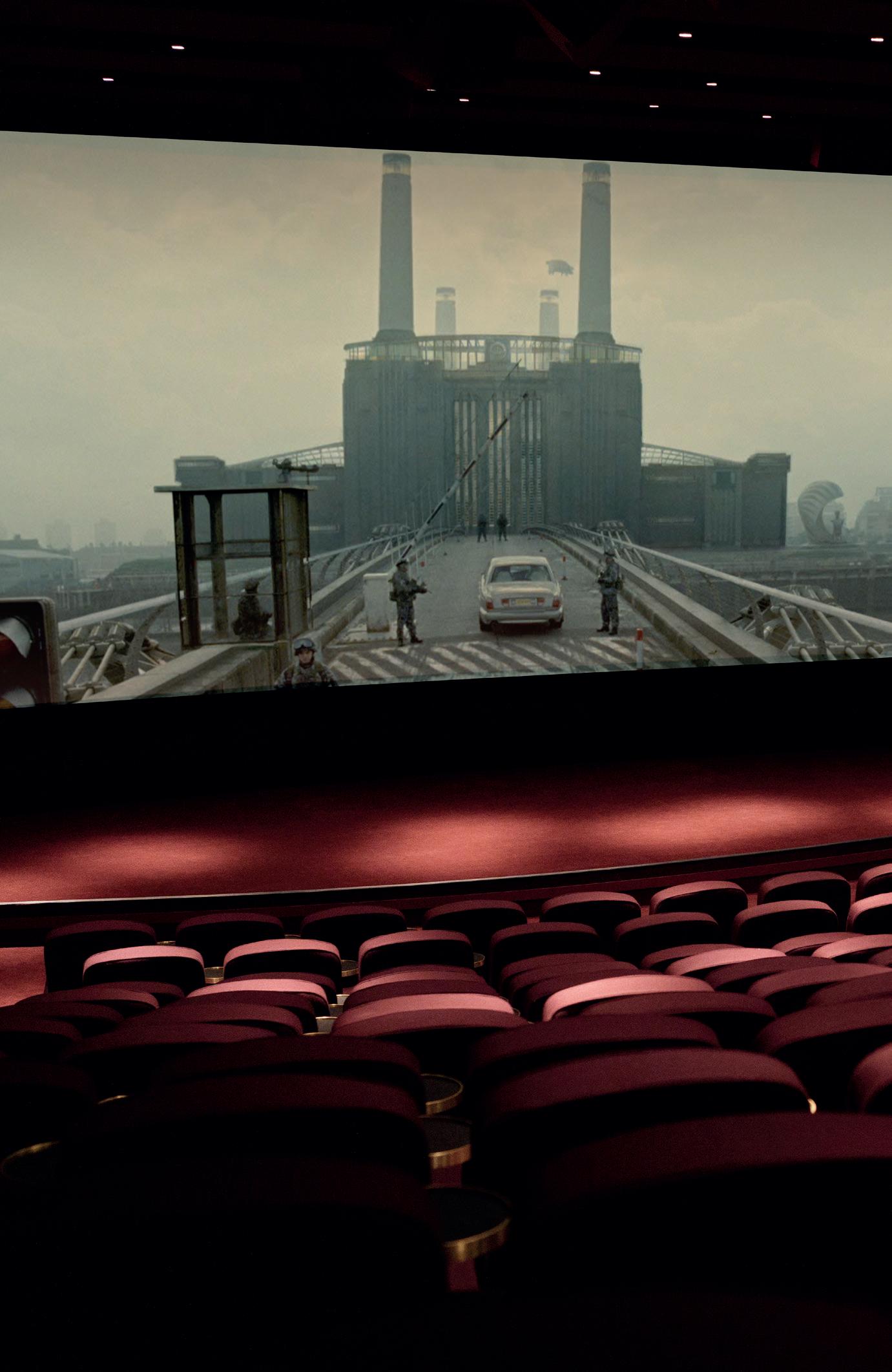 Peter Knight, Commissioning Editor, CT Magazine
Peter Knight, Commissioning Editor, CT Magazine
Dolby is a company that creates audio and visual technologies for movies, TV, music, and gaming. One of its most popular innovations is Dolby Atmos, an immersive sound technology that allows creatives to place sounds precisely in a 3D space, creating a more realistic and immersive audio experience. Dolby also offers Dolby Vision, a visual technology that enhances the colour, contrast, and brightness of the picture. Dolby’s technologies are available on various devices and platforms, such as cinemas, TVs, speakers, headphones, streaming services, and games. Dolby also provides tools and APIs for content creators to use its technologies in their projects.
Dolby Atmos has been around for eleven years, having been first introduced in 2012 with the movie release of Brave. It was one of the most revolutionary developments in sound in recent history. Moving from a channel-based to an object-based processing system with up to 64 channels (outputs) and 128 objects available, Atmos reproduces the sound in the auditorium to any specific location within the room. This provided a huge leap forwards in the audio experience particularly when comparing 5.1 or 7.1 to Dolby Atmos. The interest and subsequent take-up of Dolby Atmos became one of the fastest of any sound development in history.
Today there are more than 7000 Atmos screens around the world with the majority in the APAC territories. It is fair to say that Dolby Atmos has become the industry standard with content creators looking to utilise object-based audio to enhance their storytelling techniques. Most if not all major studio tent-poles now include an Atmos mix such is the adoption of the technology. Over the years, since the initial release of Atmos, creatives have developed tools and skills that have allowed them to be as creative as they want with the system.
Like most new premium technologies and formats, initially, Atmos found a home in large PLF screens. However, this has now changed and Atmos is becoming a more regularly installed technology in smaller auditoriums where exhibitors are seeking to add further immersion to movie-going experiences. In certain territories, multiplex operators are even installing Atmos in every auditorium.
This is due to Dolby’s commitment to making this technology as widely available as possible. Of course there is a relatively significant investment required by the exhibitor in respect of the
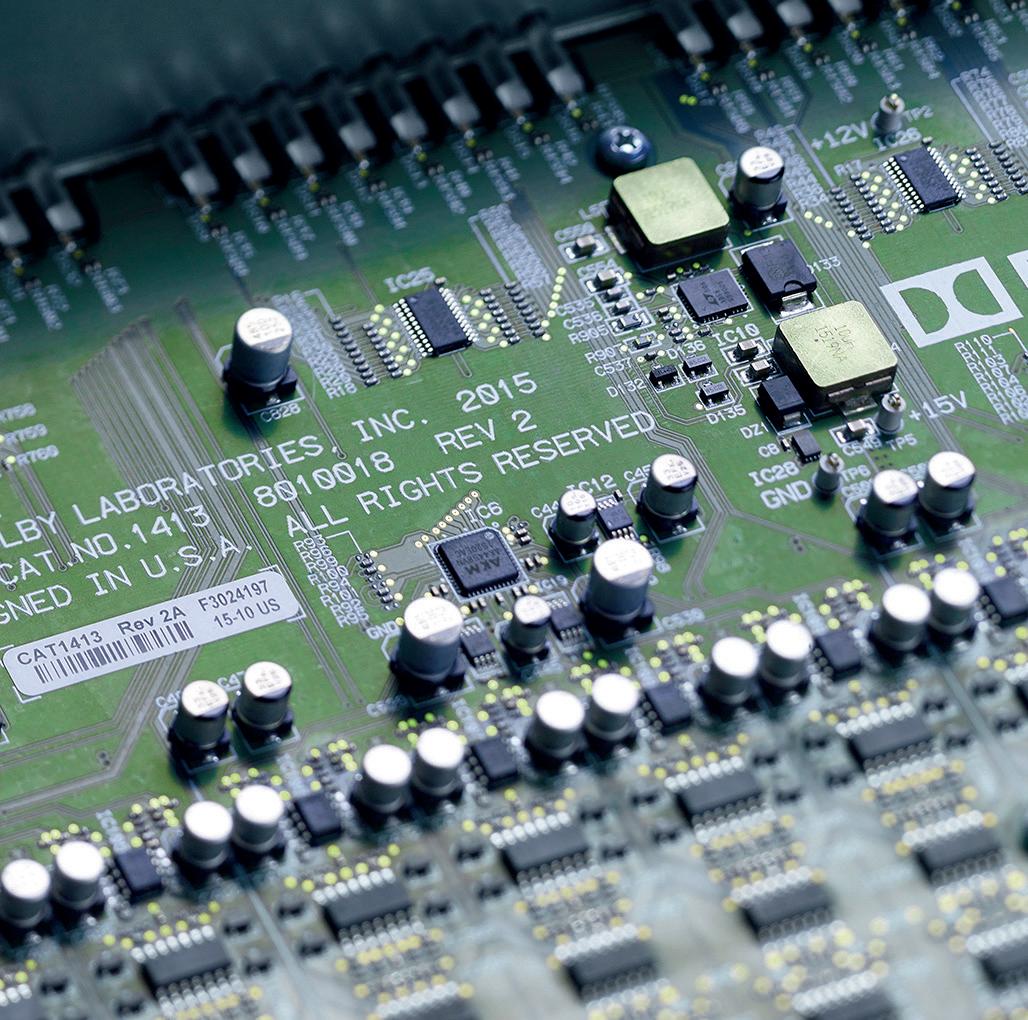
required speakers and amplifiers but Dolby is innovating to ensure it is an affordable technology for any cinema, particularly against the backdrop of an industry recovery. This affordability is achieved by optimising the system so it can flexibly playback correctly in any size environment with any number of speakers. The audio processor can have up to 64 different outputs of sound, but it can also work with a reduced number, for example 40. Every installation is studied so that it can be optimised to provide the best possible experience for the cinema-goer.
Such is its success that Dolby Atmos has found its way outside of the cinema and is now not only a part of home cinema systems but Atmos can also be found within headphones and even car audio systems. In fact, one of the biggest growth areas for Atmos currently is the motoring industry which is embracing immersive 3D sound experiences. The development of Atmos relies on the Dolby algorithm tricking the brain into thinking it is hearing audio in places where there is no sound, such as, in the binaural of a pair of headphones. It is this technology that enables Atmos to be a success even in less controllable environments such as the home.
The Dolby multi-channel amplifier (DMA) is available in different configurations. It’s available in 16, 24, or 32 channels of amplification in a single unit. In addition, the 16 and 24 channels have an analog input option, all combined in a four rack-space units tall server. A single unit with that number of channels means less cabling is required because, through an RJ45 Ethernet cable, you can have an AES67 digital signal sound from the audio or Atmos processor. There are situations where multiple DMA amplifiers may be required due to the number of speakers in the auditorium. The DMA can also be combined with different

amplifiers when the power output exceeds 1100W per bridged channel. There are other advantages to the DMA that are beginning to be seen with modern electronics, such as the rack space required for an individual DMA amplifier which is less than the equivalent number of separate amplifiers.
Talking to the Dolby team, they have been working with Odeon Cinemas in the UK and Kinepolis in Germany. In Germany with Kinepolis, Dolby conducted a power measurement test at their site in Aschaffenburg with two identical-sized Atmos screens. One screen was equipped with one of their DMA amplifiers - 2 x 16 channel DMAs and speakers, while the other one was equipped with four competitors’ products. Both systems’ power consumption was measured using the same movie clips at varying volume levels. The result was that the Dolby DMA system had a power saving of around 37%. Odeon performed similar tests with Top Gun: Maverick, where savings of around one-third were realised.

It is now eight years since Dolby Cinema was introduced at CinemaCon 2015 with the Black Dot presentation, now famous in the industry. The very first Dolby Cinema was opened in the Netherlands in December 2014, although this did not feature the laser projection solution, Dolby Vision. The first complete Dolby Cinema was installed in June 2015, although a test site was opened at La Macanista in Barcelona which showcased the concept (minus Dolby Vision) to CineEurope attendees with a full Dolby Vision installation occurring at the site just a few months later. Now nine years on there are 288 Dolby Cinemas globally of which 44 are in the EMEA region with eight in the UK.
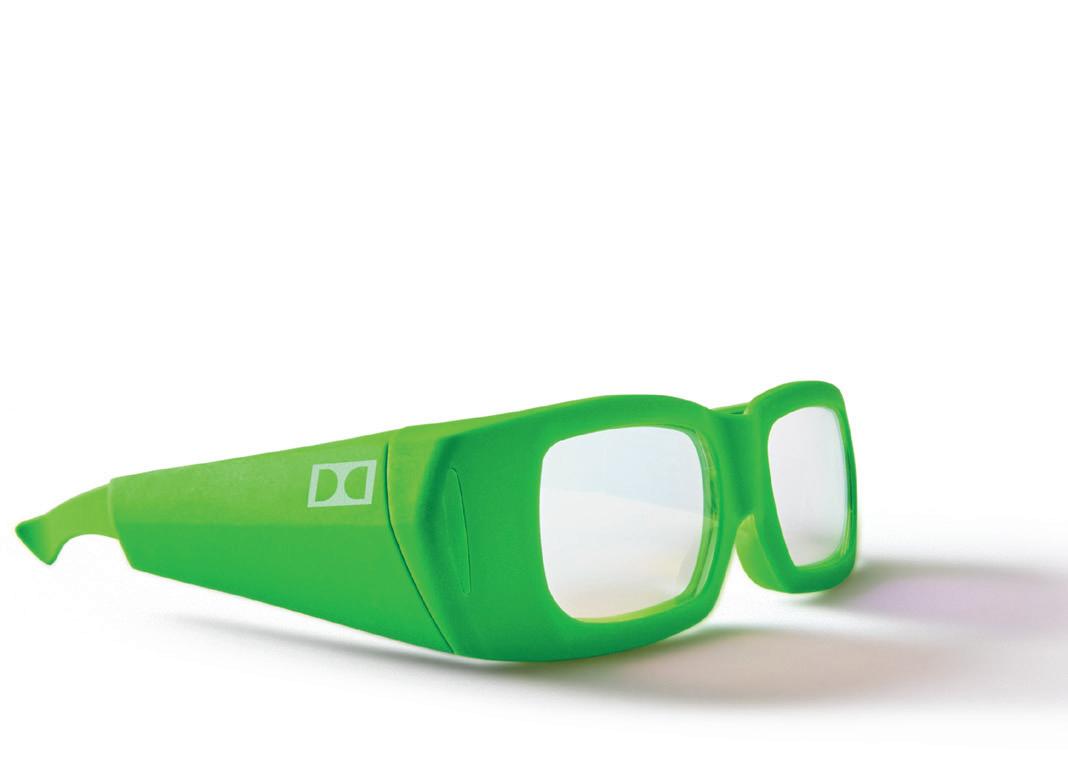

It is perhaps surprising to learn that the majority of these Dolby Cinemas were in fact installed as part of retrofit refurbishments rather than new build sites. Having pre-built spaces means that often, there are likely to be more challenges and therefore design compromises required in trying to implement an ideal design specification into an auditorium.

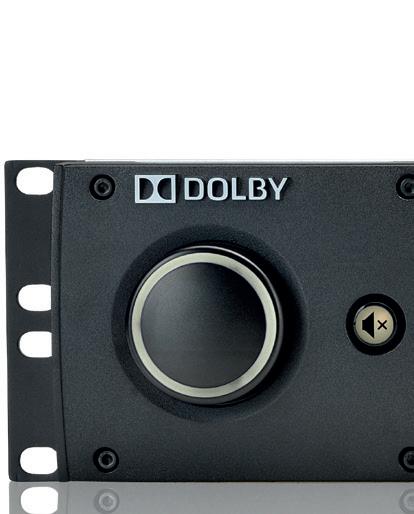

The rationale behind Dolby Cinema has always been about balancing industry presentation standards whilst also trying to achieve the best possible experience. Of course, Dolby would like as many Dolby Cinemas as possible, not necessarily purely from Dolby’s own perspective, but because of their lifelong commitment to helping film-makers and studios to showcase their content in the best possible way for audiences to enjoy. So it is really at the core of everything that Dolby does, enhancing the experience. Dolby Cinema consists of three elements with the technology, Dolby Vision and Dolby Atmos. The other component is design, and that is the one has evolved the most over the years. Dolby takes a custom-designed approach to Dolby Cinema designs. This approach starts by looking at the auditorium itself and also the surroundings of the auditorium because elements such as insulation are key in controlling acoustic performance. Anything that is added to that existing screen, especially in a retrofit, should not impact any of the other experiences or other screens within the site.

When Dolby is looking at the auditorium dimensions they consider the horizontal and vertical sightlines with an aim of ensuring each seat in the house has the best possible audio and visual experience. This is not an easy task in itself, but the Dolby team always look to develop the best possible solution for the specific room. Of course presentation excellence is one element as is removing any kind of distractions from the room. This extends to the finish of the room, removing reflective surfaces to give the room a matte black feel. Dolby do consider the covering on speakers to be an intrinsic part of the Dolby Cinema design, although Dolby will always work hand in hand with exhibitors to find solutions if retrofit requires adjustments. Now, Dolby focuses more on what they call speaker troughs, where speakers are recessed in the ceiling and because everything is black, they

blend into the ceiling. Occasionally, one of the two speakers that are really close to the screen may be covered up so that even if there is a very bright scene, they don’t reflect light, but again this is about ensuring that there are no distractions from the movie itself. Other elements that have changed and evolved include the conduction of the baffle walls and the installation of all the equipment behind the screen. That whole piece of construction was initially created in steel or aluminium and whilst very sturdy, carried a significant environmental impact and cost, particularly on a renovation project. Now Dolby has created a lighter version called a bafflette. It is a smaller lightweight version of what they had worked with which does not compromise the experience whilst having a positive impact on build time, on construction, the budget and therefore also on the environment.
Although the majority of Dolby Cinemas are currently retrofit auditoriums with exhibitors seeking to create premium offerings in existing sites, this may change in the future, perhaps led by emerging territories such as markets like Saudi Arabia. The changes in movie-going caused by the pandemic has in many ways accelerated discussions with exhibitors who are seeking to find ways to bring movie-goers back and increase frequency of visits. Whilst a custom-made approach has to be taken to retrofits, Dolby makes sure that irrespective of differences in auditoriums, a similar experience is offered in each one. Although each auditorium features a tailor-made design for the Atmos layout, Dolby ensures that the calibration of the vision system and the way that everything is installed works together in terms of the design and the layout of the room. Finer elements such as seat placement, the rake of the auditorium, and the horizontal and vertical sightlines are very important aspects of the overall experience. Focusing down on these details enables Dolby Cinema to deliver the same technological experience, images with a contrast ratio of 1,000,000:1 and a peak centre-screen brightness of 31fL in 2D and 14fL in 3D - twice the DCI standard for
Top
brightness. In some cases achieving complete blackness has proven difficult. With Odeon Leicester Square and the newly opened Cinema In The Power Station, Dolby has innovated to deliver that same experience.
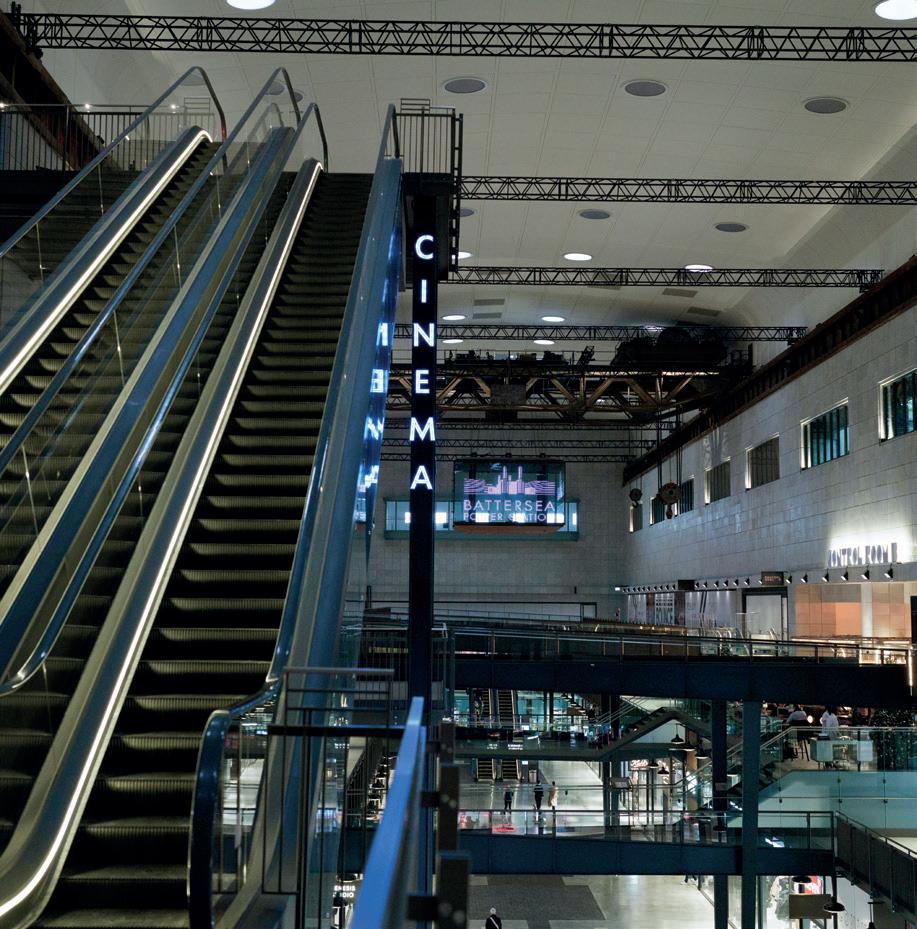

The popular IMS3000 server with an optional sound processor, both for 5.1, 7.1 as well as Dolby Atmos, features three storage options (3 x 1TB, 3 x 2TB or an external NAS with a total usable capacity of 10.5TB and 16TB of total capacity). The flexible CP950 sound processor works with 5.1 and 7.1 screens and the CP950A is designed with Dolby Atmos in mind. Recognising the need for cinemas to be able to adapt and with Atmos growing in popularity, the CP950 sound processor has the ability to be upgraded by inserting the Dolby Atmos card into the processor.
In 2014 Dolby acquired US-based speaker company SLS Audio and over the past few years, the complete product line of speakers has been redesigned to meet the needs of current cinemas. For example, the front speakers (System 136) are Dolby’s biggest speaker line for front screen systems providing audio for screens up to 15m in width. Besides that, Dolby has also designed and developed a complete range of surround speakers from DSR1090, (which is a ten-inch surround speaker) to DSR1260 for surrounds and DSR1280 for ceiling speakers and on subwoofers, Dolby has recently introduced a new subwoofer called SB218XL. Being owned and developed by Dolby, it is unsurprising that the dispersion (vertically asymmetric) is perfectly shaped for modern cinemas. The angle in the low range of the aiming of the speaker is wider and it narrows to shape the room to the stage of the room. It has much better coverage for the audience and lower distortion with a higher dynamic range. This enables better audio not just to the centre of the auditorium but to every seat in the auditorium.


It’s clear that Dolby continues to innovate and bring revolutionary technology to the entertainment industry. Dolby Atmos and Dolby Cinema are redefining the way movie-goers consume films, immersing audiences in breathtaking soundscapes and spellbinding visuals. But Dolby’s determination to unveil innovative technology and promote sustainability sets it apart from the rest. This commitment has enabled the company to maintain its position at the forefront of premium entertainment experiences for decades. As the industry recuperates from the pandemic, it is Dolby’s constant advancements that are projected to play a crucial role in defining the future of cinema. So, we can rest assured that they will continue to astound us with their exceptional technology that enhances our cinematic experiences!
A bullish start to 2023 has delivered further proof that box office recovery is reaching its final stages, as we head into the summer blockbuster period with the strongest slate of the decade to date. Already this year, after a better than expected first quarter, forecasters Gower Street Analytics have raised their 2023 global box office estimate from $29 billion to $32 billion. This would represent a further 23% improvement over the significant gains of 2022.
Awelcome Christmas gift was delivered across all territories by James Cameron with Avatar: The Way Of Water becoming Europe’s highest-grossing film of all time and playing well into the new year.
Audiences’ appetites for premium formats and VIP luxury have grown significantly as they seek outof-home experiences that deliver added value.
Germany and France are closest to matching 2019 box office levels. There are significant variations across territories, with UK & Ireland recording just a 5% increase year-on-year for 2023 to date, much lower than our European neighbours and despite a strong January performance. From mid-February to the end of March, the top films this year – led by Ant-Man And The Wasp: Quantumania and Puss In Boots: The Last Wish – struggled to match the £40m achieved by The Batman last March, alongside last February’s Uncharted also exceeding expectations. 2023 is likely to be a more consistent year than we have seen postpandemic so far, progressing away from the pattern of only a small number of titles hitting big and indicating greater depth in the slate. Local titles are a major driver of European box office
success, particularly in France. Their productions also travel well across borders with three of the top four European films hailing from France, led by family comedy sequel Astérix et Obélix : L’Empire du Milieu. Following its initial release in February, this film had played in over 25 European territories by the end of April, with major markets including Germany still to come in May. The top German title at home and across Europe is also a family sequel, Die Drei ??? – Erbe des Drachen.
Several other developments are driving growth in recent months, across the diverse range of audiences needed for a healthy sector. Dominant among these is the increasing trend for sequels in well-established franchises to cross over to new audiences and out-perform their previous instalments – not only opening bigger as we might expect, but holding well for many weeks. Alongside Avatar, the latest chapters of John Wick, Creed and Puss In Boots have all broken out above their previous benchmarks. John Wick: Chapter 4 has come close to exceeding the box office of the prior three instalments combined in UK & Ireland, and has far exceeded the gross of 2019’s Chapter 3 in every territory across Europe from Turkey and Greece to Denmark and Austria. The European filming locations including Paris and Berlin may have helped – and bodes well for Fast X in May which has an extensive action sequence set in
Rome and a trip to London. Families have crowded back into cinemas to enjoy several mega hits, led by Universal Pictures’ Puss In Boots: The Last Wish and The Super Mario Bros. Movie smashing expectations worldwide and taking two spots in the European Top 5 of the year so far. Also in the European Top 10 is Dungeons & Dragons: Honor Among Thieves. And it isn’t only Hollywood films that are pulling in families, with French sequel Astérix et Obélix : L’Empire du Milieu and Spanish/US coproduction Mummies also in the Top 10. At the other end of the age range, quality adult dramas are again finding robust interest from cinemagoers, despite strong competition from streaming platforms both at the acquisition stage and for audiences. Finding the right venues and release dates is now more important than ever to cut through and attract the relevant audience as the number of releases returns to its full volume. A good mix of Hollywood and local titles have achieved success this year from Babylon, A Man Called Otto, The Fabelmans, TAR, Air and The Whale to The Banshees Of Inisherin, Empire Of Light, Sonne und Beton, Sur les Chemins Noirs and Le Otto Montagne.
Horror is a genre that has always been embraced by young adult cinemagoers, benefitting from the communal experience of a darkened room, but this has escalated post-reopening with breakthrough titles including M3GAN, Scream VI, Evil Dead Rise, Cocaine Bear and Knock At The Cabin. Watching at home simply doesn’t compare to sharing the scares with a crowd.
Across Europe in 2022 we saw the success of various National Cinema Days in drawing back those who had fallen out of the cinema-going habit. The high quality and diversity of the summer slate is sure to keep them coming back for more, and we look forward to more successful Cinema Days later this year to maintain this momentum in the traditionally quieter months.
Returning to a full release slate is widely welcomed but of course brings its own challenges, particularly for cinemas with fewer screens. Selecting the most appealing titles for the local audience at each cinema, both individual films and a balanced programme to maintain the cinema-going habit across diverse
audience sectors; programming shows at convenient times, taking into account post-pandemic work and leisure patterns; holding films for second, third and fourth playweeks when every weekend brings major new releases. The relative shortage of major blockbusters last year meant successful films enjoyed extended play periods but cinemagoers rationed their visits and turned out less frequently, with the gap in European admissions improving but still around one-third lower than 2019. The multi-faceted offering of the compelling release slate and upgraded cinema seats and screens, combined with an anticipated repeat of the successful Cinema Days discount events to tackle the cost-of-living issue, gives us a great opportunity to get audiences back in the habit and close the remaining gap.

Supplying international cinema multiplexes for over 40 years and featuring in over 4000 screens worldwide.

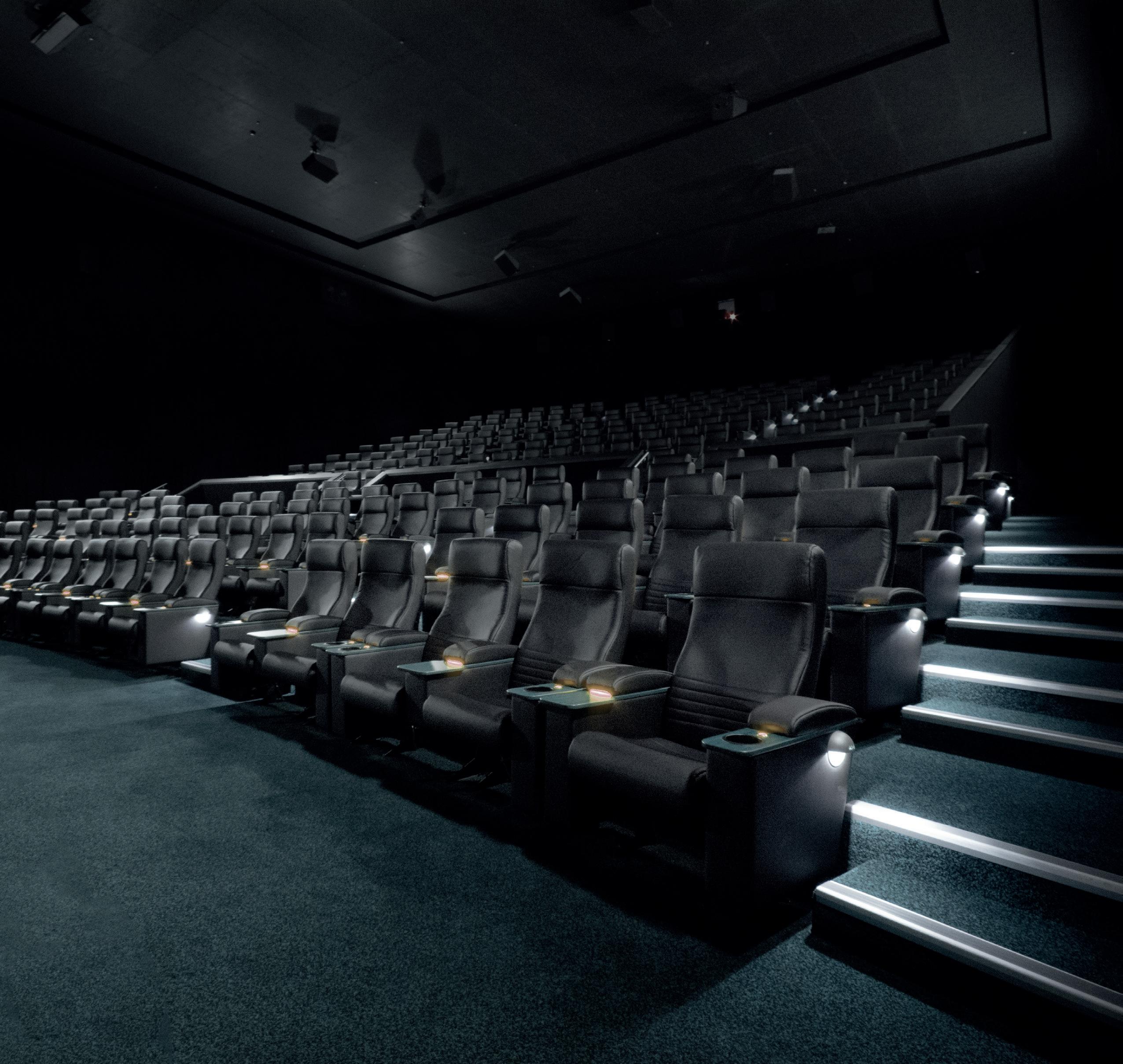
Krix commercial cinema speakers provide a vast, immersive sound with optimum dispersion, vocal intelligibility, and responsive bassensuring every movie soundtrack is delivered with clarity, control and effortless power.


For the ultimate cinema experience, play it through Krix.
krix.com/cinema

 Dr Henrik Axelsson, President, KenCast
Dr Henrik Axelsson, President, KenCast
Over the past few decades, the physical delivery of celluloid film reels and hard drives has been replaced by complex, high-performing digital distribution networks that make use of the very latest advances in file transmission technology. It might surprise many a movie-goer to know that the latest Hollywood movies often journey from production suites to satellites thousands of miles in the sky and back again to be projected on the silver screen.
For content distribution networks – sending either local independent releases or global blockbusters to cinemas – that are reliant on the assured and timely delivery of their movie files, it’s imperative that the right distribution method is chosen and that the technology supporting it is best-in-class.
From silent films to the talkies, from Cinecolour to 4DX, the movie experience has dramatically changed since the early 20th century. The way in which these films make it to cinema screens around the world has been no less revolutionary.
For early theatrical releases, movies had to be physically reproduced thousands of times onto celluloid reels and distributed to individual cinemas. Aside from the cost – at an average of $2,000 per print – time and effort of production and distribution, the material was flammable and posed a safety risk. The technology advanced and better material was invented, like magnetic tapes. To this day, some directors still prefer for their movies to be shown on physical film in cinemas, favouring the tradition and aesthetic.
It wasn’t until 2002, with Star Wars: Episode II: Attack of the Clones, that a major release was digitally released in major markets. The motion picture industry’s conversion to all-digital is one of technology’s greatest success stories as there are over 200,000 digital cinema screens today, up from less than 3,000 at the time Episode II was released.
Today, a digital file is the typical method of distribution. It can be sent in two ways. The first is physical delivery of a hard drive that stores the movie. Each cinema gets one copy of the movie and will copy it from the drive to the servers in each auditorium where the movie will be shown. By shipping movies on removable and reusable hard drives, studios saved billions of dollars. In the United States, this was the early method used when analog film
reels were digitised but still too large to digitally distribute. Rare today in the US, there are some countries where bicycle messengers still bring hard drive films to cinemas.
The other distribution method is to transmit the movie file digitally. Not only does this save the time required to physically ship hard drives, it saves the labour and production costs. However, such highly efficient distribution requires a reliable, high-bandwidth network to be successful. As mentioned above, early terrestrial internet networks were not capable of delivering such large file sizes. Instead, satellite networks were used. Over the years, technology innovations in high-capacity fibre networks have made them a great option for digital content distribution.
Terrestrial delivery networks like Content Delivery Networks (CDNs) are costly to scale, however. For small-scale releases –independent movies, for example – utilising a CDN is the economical option. Yet as soon cinema networks scale beyond around 400 sites, it becomes incredibly cost-ineffective and rapidly more expensive as more locations are added. Moreover, in emerging markets, and regions with unforgiving terrain or economic barriers to deploying terrestrial networks, it becomes an even less feasible option. In some large markets that still do not have reliable and widely available terrestrial connectivity, Quality of Service (QoS) can be hard to guarantee, especially for live events.
Fortunately, there is a great alternative. Satellite has occasionally been considered as an expensive technology to cover the areas where terrestrial networks do not exist. However, that perception overlooks satellites tremendous utility. Satellite connectivity can achieve very high bandwidth and data rates,
Looking at the graph (below), we can see that the cost of a satellite-based content delivery network only increases marginally if a network goes from 400 cinemas to as many as 3,000. Essentially, the cost doesn’t change depending on whether you’re reaching a few hundred to thousands of viewers with your movies.
plus built-in redundancy makes such networks dependable, delivering constant connectivity. Satellites can be deployed without the same degree of capital expenditure that a terrestrial network will often demand. Operating expenditure is typically lower too and, perhaps most importantly, it is highly scalable.

In fact, Howard Kiedaisch, the CEO of Digital Cinema Distribution Coalition (DCDC), which was founded by the heads of leading U.S. studios and exhibitors – including AMC Theatres, Cinemark Theatres, Regal Entertainment Group, Universal Pictures, and Warner Bros – recently remarked, “Though there is a lot of excitement about broadband solutions and talk of satellite distribution being an antiquated technology, it’s by far the most cost effective and reliable method to transmit our content at this time.”

Whereas terrestrial network requires a wired infrastructure connection at every point along a transmission from origin to the cinema, a satellite network has no such “last mile”. Instead, it requires the placement of a parabolic reception dish at the site that points at the geostationary (GEO) satellite sending it content. Because a GEO is always in a fixed position relative to the earth, the antenna never needs to move. The content, or files, are transmitted by headend software and hardware at a teleport, thousands of miles into the sky and then back down again to every cinema satellite dish in its footprint. The film digitally travels from the antenna through the wiring within the cinema to the projection booth where it is stored on the library server and then available for playback in the auditorium for cinema goers. Most digital cinema software will include a Theater Management System (TMS).
When delivering content via satellites, multicasting, or the transmission from a single source to multiple (usually widely dispersed) points is the common method. Multicasting is unparalleled in its ability to simultaneously reach a nearly unlimited number of geographically dispersed sites. With a single transmission the movie can concurrently be received at a cinema in Alaska, Florida (and thousands of sites in between!).
It is not error-proof, however – files are affected by delay, degradation and deletion. The result could be an incomplete or damaged file, which is unusable by cinema networks and content distributors who depend on the assured, faultless, and seamlessly delivered content. Adding to the challenge is the fact that, while file transmission is always error prone, the likelihood increases significantly the larger the size of the file. Although the average film file size is about 250 gigabytes, there are many films over 1 terabyte. Although it is possible to continuously send files
Kencast’s technology supports DCDC’s delivery of live content distribution into cinemas throughout the network of 33,000 screens in over 3,000 cinemas.
multiple times to ensure that all content is fully received, it is highly inefficient and costly. Instead, a mathematical concept utilising algorithms to correct for errors was developed to solve errors on the fly. These algorithms are referred to as Forward Error Correction (FEC). Although the math is complicated, the concept is simple. It is possible to think of FEC like a Sudoku puzzle where if a user receives enough numbers, they can work out what the missing ones are. If an algorithm can solve for all the missing pieces, it can complete the entire file or stream. However, not all FEC algorithms operate in the same way and not all FEC technologies are equal. If you are a leading distributor of films to cinemas and want to stop sending content out on bulky hard drives and start sending with satellite multi-casting, the highest quality FEC will ensure the most reliable delivery of files the first time they are sent – despite errors that may have occurred during transmissions!
The better the algorithm, the higher the efficiency of error correction, the greater the reliability of delivery, the faster the speed for a complete transmission and the larger the cost savings on retransmissions. It is important to know which level of FEC your network uses.
KenCast’s digital cinema solution is installed in over 5,000 cinemas worldwide.
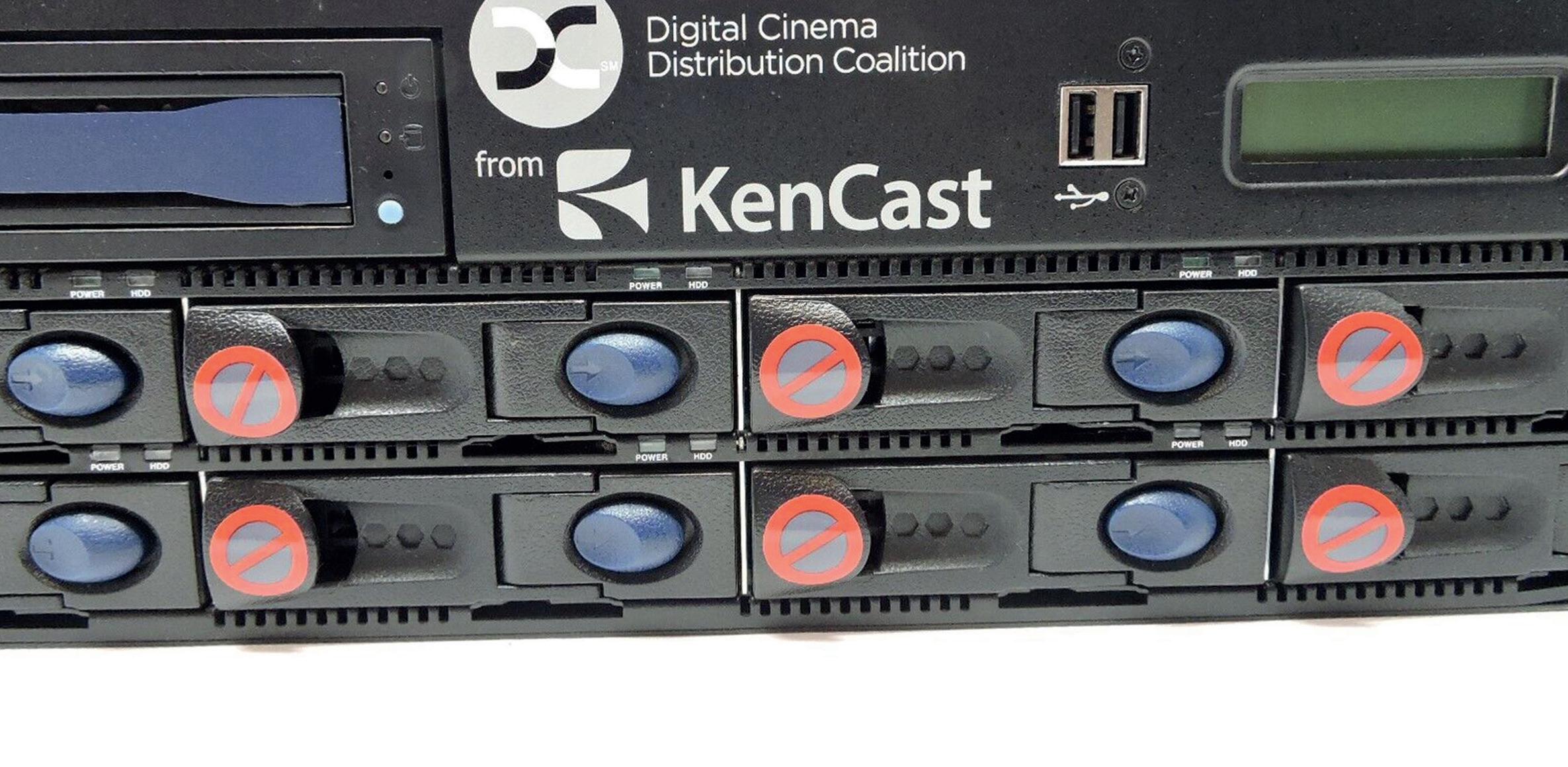
Apart from world-class FEC, custom workflows and functionality must be added to any digital cinema ecosystem to address the mission critical requirements of content distributors. This is an end-to-end process that includes sending, scheduling, encryption, bandwidth and other delivery services. At the transmitting site, FEC and a sophisticated Content Management System that monitors and actively optimises the performance of the network is embedded in enterprise grade server hardware. At
the cinema side, a sophisticated appliance with specialised receive software resides in the projection booth with ample storage to accumulate dozens of films for playout. If the cinema is interested in playing live sports, music or other events, a decoding device is needed to uncompress encoded or compressed video audio streams.
When all this comes together, a fully optimised digital cinema network can deliver theatrical content to thousands of cinemas and in turn to millions of satisfied film goers. In the United States, Hollywood’s Digital Cinema Distribution Coalition (DCDC) was tasked with finding such a solution. In 2012, it realised that even more cost and errors could be driven out of the delivery process by replacing the shipment (and return) of bulky hard drives with satellite multicasting. DCDC selected KenCast as their technology partner and, over a decade later, its leading technology supports DCDC’s delivery of feature, promotional, pre-show and live content distribution into cinemas throughout the network of 33,000 screens in over 3,000 cinemas.
The world’s second largest exhibitor, Cinemark, also partners with KenCast to ensure the distribution of theatrical content throughout fifteen countries in Central and Latin America. Including the CinecolorSat network, the largest digital cinema delivery operator throughout LATAM, KenCast’s digital cinema
solution is installed in over 5,000 cinemas worldwide.
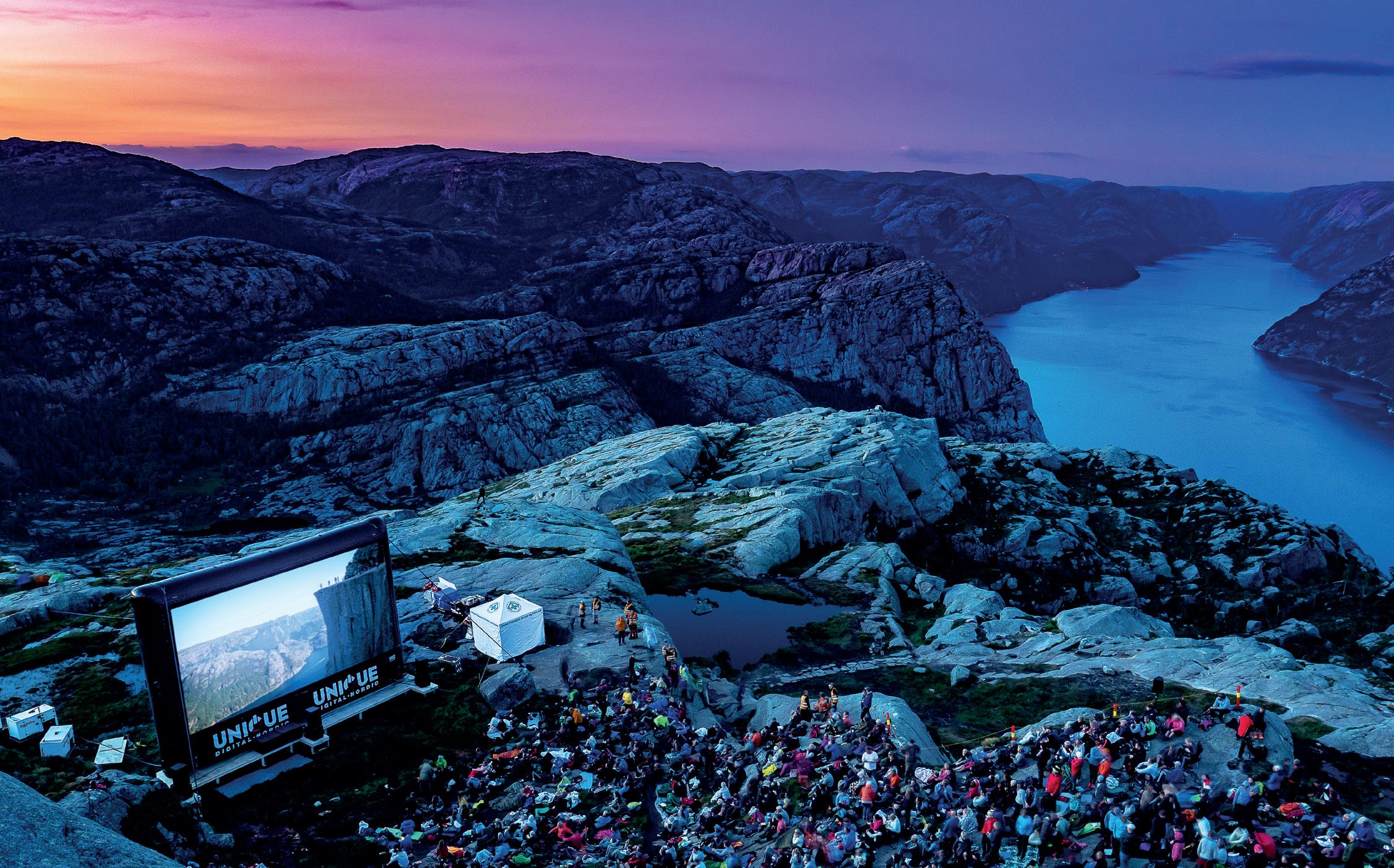







KenCast’s solution, which supports both satellite and terrestrial networks, has also bolstered DCDC with growing its live content capabilities. Live events and other alternative content has seen some of the fastest growth in the cinema business. Over a 12 month period, DCDC was able to double the number of sites capable of showing live content – whether sports, concerts, or more – and is now approaching 900 liveenabled sites. The same solution is used by CinecolorSat throughout LATAM to deliver live concerts from artists like Coldplay and BTS, as well as for a number of UFC fights.
As the digitisation of cinema continues and file sizes grow through increasingly higher resolution standards, it’s imperative for content distributors to ensure that their distribution methods harness the most advanced technologies on the market. Field tested proven solutions allow exhibitors to focus on cultivating a memorable experience for fans and provide operators invaluable peace of mind.
Despite a perception as a poorer performing and more costly alternative to terrestrial, when scaling a network for live events and feature film releases, it is clear that satellite is far more cost effective and offers superlative performance for many cinema networks.
AIM: To describe what the Low-Carbon Modular Cinema is, how it works, what the benefits are and what makes up the structure of the walls
CT: You’ve both been in the industry for a long time, but please introduce yourselves to our readers who may not know you.
Stefanie Fischer: During my career as an Architect I’ve built up a reputation for my work in the independent cinema sector in the UK. I’ve led projects for cinemas including the Depot Lewes, Campbeltown Picturehouse and Newlyn Filmhouse, Rio Dalston, Broadway Nottingham, Exeter Picture House, Cine Lumiere, Norwich Cinema City, Scala Cinema and Arts Centre Prestatyn and Kino Hawkhurst. I currently provide cinema consultancy services through Philip Meadowcroft Architects. Some current and recent projects include a refurbishment of Regal Wadebridge for WTW Scott Cinemas and an appraisal for Shrewsbury Council on the inclusion of a 4-screen boutique cinema within a repurposed shopping centre.
Ron Inglis: I have undertaken cinema consultancy projects over many years for numerous organisations and agencies including the UK Film Council and the BFI. I have been employed as a research and cinema development consultant on projects across
the UK and Ireland most recently on the new Regent cinema in Redcar and a multi-use venue in Blyth due to open in 2024.
In 2008 I set up Regional Screen Scotland, an organisation that advocates for cinema provision in Scotland and runs the mobile cinema Screen Machine that tours the Scottish Highlands. I was Director of the organisation until 2014, when I was appointed as Project Manager for the Centenary Project at Campbeltown Picturehouse, which included the restoration of the historic cinema.
CT: Tell us about this latest collaborative project - the LowCarbon Modular Cinema. How and why has this concept come about? How long have you been working on it?
Stefanie: In the years preceding the digital transition, I carried out a research project, together with Ron, on the potential for digital distribution and exhibition, coupled with modular construction, to open up new viable models of cinema in underserved rural and small town areas.
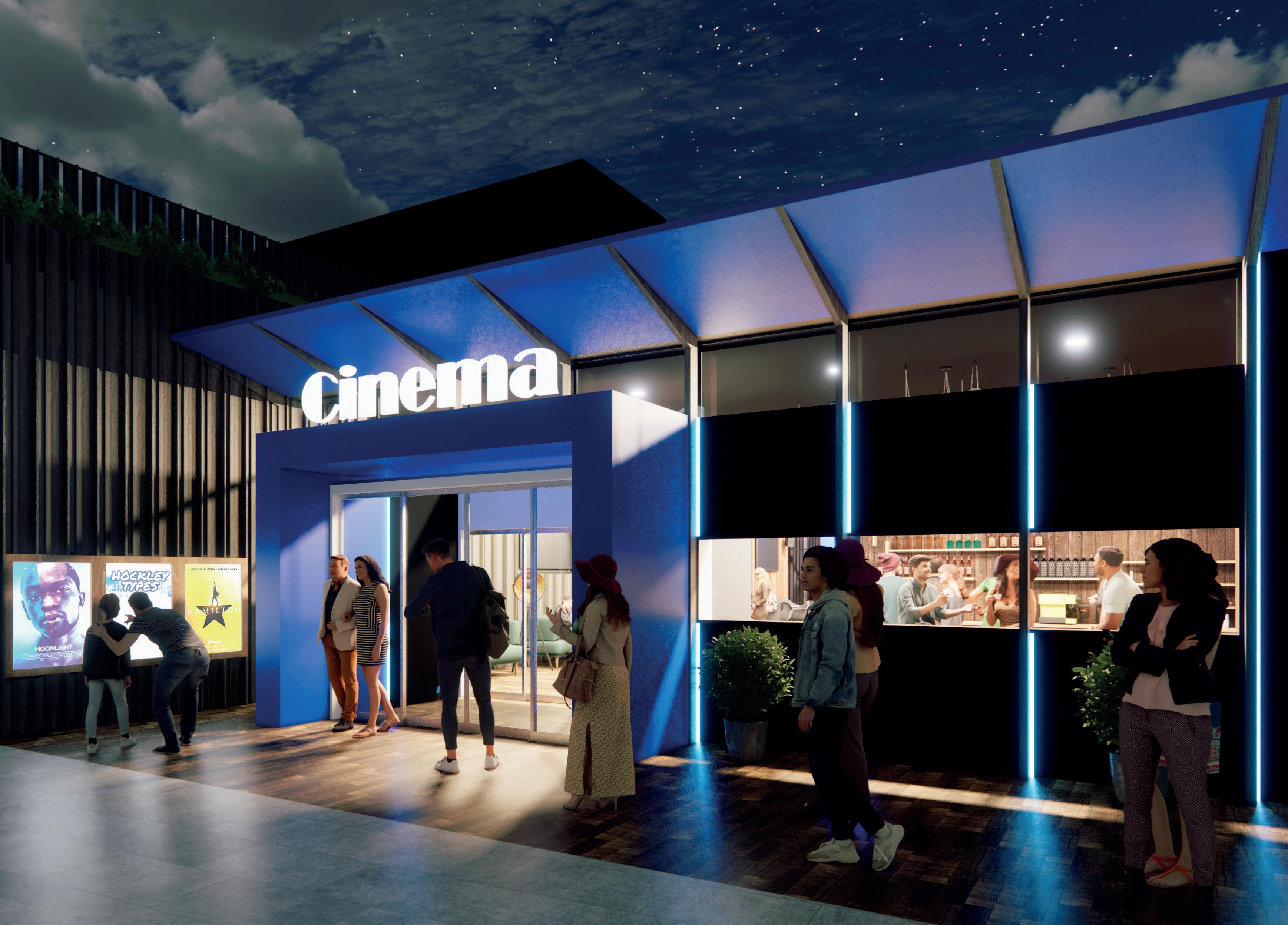
Ron: The initial inspiration came partly from the Market Town Template concept which proposed a menu of facilities small and medium size towns should aim to provide, from health services through to leisure and entertainment. We focused on modular construction because we wanted to develop a ‘product’ which would shorten the lengthy development periods experienced by many independent cinema projects and make it available at a predictable price.
The climate emergency and energy crisis broadened the objectives of the concept to develop a net zero, carbon negative cinema that reduces both embodied carbon and operational carbon. The benefits to cinema operators include reduced energy costs and access to funding through carbon trading.
CT: Please explain a bit more about the concept.
Ron: InventaCinema is a new concept in state-of-the-art neighbourhood cinema. Created using offsite, modular and lowcarbon technologies the aim is to create a vibrant social and leisure hub incorporating a cinema to locations and communities where there is limited access to a high quality cinemagoing experience.
Stefanie: We formed the company in 2022, along with John Morgan of Leonard Design Architects. With a focus on finding solutions to the energy crisis, we identified Agile Properties and Homes as the manufacturing and delivery partner, drawing on their Agile Build System, which is based on the use of timber, compressed and chopped straw, to meet the goal of developing a net zero, carbon negative cinema. Of course, the modular construction, using the Agile Build System, not only meets the net zero, carbon negative target but addresses the objectives of making the cinema available at a predictable price and reducing cost and programme risk to the Client.
CT: Can you explain how the modular/off-site approach works?
Stefanie: The modular approach offers many different configurations. There is a common core of front of house accommodation including: an entrance foyer with informal seating, a single sales point for tickets, food and drink and a café
Stefanie: The typical 3 screen InventaCinema, stores 1,103 tonnes of CO2. The low carbon services strategy eliminates the need for mechanical ventilation and cooling of the cinema auditoria, resulting in a significant reduction in operational carbon; HVAC accounts for approximately 70% of the energy use of a cinema. Each product selected for the fit-out contributes to the low carbon objectives. The auditoria would be fitted with energy efficient laser projectors. It is underpinned with a cleanrenewable energy strategy summarised as follows:
Stefanie: Agile Homes and Properties believes that using prefabrication, vehicle movements to site are reduced by up to 50%. One truck can deliver 10 wall, floor and roof panels to site. The typical 3 screen cinema is made up of 209 panels = 21 deliveries. With on site construction, site deliveries would be significantly higher.
On a completed low carbon modular project, the efficiency savings included:
Faster onsite installation
1 5 6 7
2 3 4
Minimal Optimised transport solutions to reduce costs
Overall reduction in operational and embodied carbon
Safer working environments for personnel
More likely to meet programme deliverables & reduce commercial risk
The combination of which typically delivers:
44% improvement in costs
27%
Carbon Dioxide reduction on fabrication and delivery.
75% reduction of rework compared to onsite construction.
80% reduction in notifiable H&S incidents. Overall 25% nett efficiency (cost reduction) compared to conventional on site construction.
75% improvement in time to install.
bar with 40 covers inside and an outside seating area and back of house accommodation including: visitor toilets, cleaners store, staff office and welfare facilities, kitchen, bar and kitchen stores and refuse and recycling stores. A combination of cinema modules can be accommodated along the circulation spine depending on market demand and site capacity. Additionally, individual cinema modules can be added to existing cinema buildings or other leisure or educational buildings or inserted within the large clear span of buildings such as former industrial buildings.
Clean-Renewable Energy Strategy
MEAN
InventaCinema starts out with the position that it should use no energy and, instead, carry out a ‘managed retreat’ from this position. This approach changes the way in which design teams perform, from seeking marginal improvements to more radical ones.
CLEAN-RENEWABLE ENERGY STRATEGY
The large flat roof allows for arrays of Photovoltaic Panels and Solar Hot Water to be deployed, connected to a battery to spread demand throughout the day.
A consequence of the performance of the envelope is that the active systems of InventaCinema have less work to do in terms of energy consumption to maintain year round comfort for occupants.
InventaCinema has a large area of green roof that further attenuates heat loss, contributes to acoustic performance, contributes to biodiversity net gain and attenuates rainwater run-off.
InventaCinema aims to minimise both embodied and operational carbon. The Agile Build System addresses both aims and the addition of solar PVs and battery storage provides important environmental benefits while contributing to the operational efficiency of the cinema.
The cinema roof is designed as both a solar and green roof. The density of PVs is balanced to support the roof’s biodiversity. A full array of PVs would provide 128 kW peak of energy. The array, if the cinema were sited in London, would produce circa 124,100 kWh of energy per year. The InventaCinema consumes circa 100 kWh per m2 pa. At 891 m2, the Cinema uses 89,100 kWh per annum.
Ron: There has been a welcome growth in the number of new local independent cinemas over the past decade – usually for up to 3 or 4 screens per site – and there are opportunities for many more. The modular approach enables configurations to be tailored to suit specific site and client circumstances. Building cinemas in this way enables a predictable out turn cost, optimised transportation of building components, predictable build quality, reduced defects, shorter project delivery times and reduced risk.
Agile Properties and Homes are in the process of completing the first Trade for Carbon Storage in the built environment with a FTSE 100 company. The build system used in the typical 3 screen InventaCinema, modelled as part of the proof of concept feasibility study, stores 1,103 tonnes of CO2e in total. At a trade price of €90 per tonne, the storage would contribute up to €99,270 towards the capital cost of a new cinema. The ongoing storage charge, over and above the original trade price , would be up to €5,115 annually.
A Community Renewal Fund grant enabled a proof of feasibility study to be carried out by InventaCinema Ltd and Agile Properties and Homes. This was completed in December 2022. While three different cinema modules [95, 60 and 14 seats] were developed as part of the feasibility study, the maximum clear span of the Agile Build System would enable auditoria of seating capacities up to 200 to be developed.
CT: Why now? Why hasn’t this been done already?
Stefanie: Over the years that Ron and I have been working on the modular cinema concept we approached a number of manufacturers of modular systems. Volumetric units, which can be fabricated and fitted out off-site, then transported on the back of a lorry for on-site assembly while suited to the front and back of house accommodation, could not be used to achieve the footprint and volume needed for the auditoria. There was also a focus among manufacturers of modular systems on servicing an expanding residential market and addressing
The array could meet the demand, but only during the day, and peak energy consumption at high load periods, for example on Saturday afternoons, would be higher than the PV array could produce. Sufficient battery storage capacity allows the cinema, over any given year, to be Net Zero by balancing peak demand to even out demand with supply.
demand in the education sector. There was not an appetite for investing in R&D to meet the needs of the cinema sector. Agile Properties and Homes came onto my radar when, as ModCell, they developed a timber and straw panel system with the University of Bath. They later developed the Agile Build System comprised of timber and chopped straw. Securing Community Renewal Funding for the proof of concept feasibility study enabled us to bring Agile Homes and Properties onboard to carry out the R&D for the low carbon modular neighbourhood cinema in collaboration with InventaCinema.
CT: For futureproofing, can the cinema be expanded and customised?
Stefanie: The modular concept and arrangement of cinema modules along the spine would enable the spine to be extended to accommodate additional cinema modules, depending on site capacity. Of course there is flexibility for operators to ‘brand’ the interiors and flexibility over the selection of cinema seats. The choices would however be subject to not undermining the
In perspective, the amount of CO2 stored.


1 meteric ton carbon dioxide
1,103 tC02e (actual vol of gas)
low carbon objectives of the InventaCinema Brand proposition.
The structural envelope of an InventaCinema is a unique, load bearing, carbon-negative, prefabricated building system that combines super-insulating renewable materials with exceptional acoustic performance and provides 1 hour of fire resistance. The panels comprise a build-up of chopped straw, compressed straw board and wood fibre board. External finishes include larch cladding or lime render with a scraffiti/pargeting decorative finish. The Agile Build System is certified for a 60 Year Design Life. This is an industry standard and does not mean that after 60 years it might fail, instead this is a minimum standard required by banks in order to be able to lend. It is a housing standard and, in effect, is the equivalent of two, twenty five year mortgage terms plus ten years.

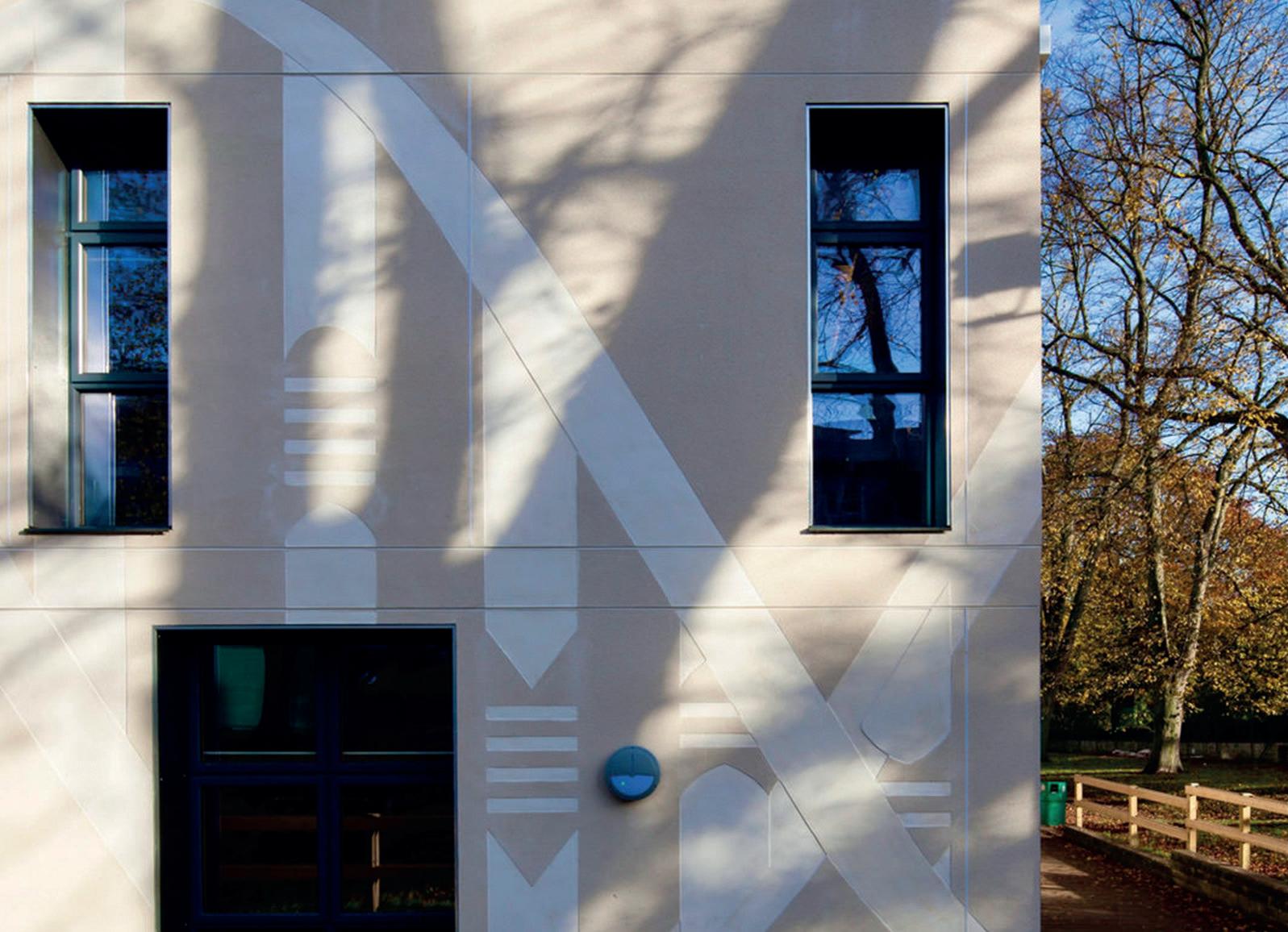
CT: The structure of the modules helps create natural air flow, how does this work and what are the benefits?
An InventaCinema does not sit on concrete foundation. Instead the structural loads are transferred to ground via an array of ground screws or pads. This creates a void between the underside of the floor panels and the ground that can be used as part of the passive ventilation system for the cinema.
The supply air is drawn through a labyrinth in the void and is attenuated to avoid outside noise disturbance. The air is preheated/cooled with a heater battery powered by solar PVs supplemented, if necessary, with electricity from the grid from a green energy supplier before entering the auditoria under the seating tiering. Air is extracted at high level and attenuated before being discharged externally to prevent noise break out from the auditoria. The principle of displacement ventilation, that is introducing air at low level and extracting it at high level, so it is drawn away from the audience, is favoured for health reasons in the post Covid era.
CT: There are clearly lots of benefits to the system, but are the circumstances where the low-carbon modular cinema is not suitable?
Stefanie: The concept is primarily intended for a stand-alone
https:// inventacinema.
neighbourhood cinema venue. However one or more InventaCinema modules could be inserted within the volume of an existing building that is being repurposed, and this might be applicable to former Shopping Centres on High Streets, or former industrial buildings with large column free floor plates and sufficient clear height.
The Agile Build System does not lend itself to other accommodation being constructed above it. An InventaCinema could however be constructed on top of a flat roof of sufficient footprint and load bearing capacity, for example on the flat roof of a multi-storey car park.
CT: At the moment this is a concept design - do you have any plans for a real-world development?
Ron: We are currently investigating the potential for an InventaCinema in three medium sized market towns in England and as part of a town centre regeneration project in Scotland.
Stefanie: We’re also currently exploring the potential to add the 60 seat cinema InventaCinema module to a Grade II listed single screen cinema with an adjoining yard in North London.
The InventaCinema concept offers substantial benefits to clients and communities seeking to provide a neighbourhood cinema in underserved rural, small town and periphery of city areas with a low carbon approach at its core.
Stefanie will be delivering a presentation in a focus session at CineEurope at 14.30 on 20 June 2023 entitled ‘Developing Net Zero Carbon Negative Neighbourhood Cinema through the use of offsite, modular and low carbon technologies.’ This presentation is free to attend for all CineEurope attendees with access to the tradeshow floor.
Deliver a blockbuster experience satisfying the highest expectations of today’s cinema-goers. As a leading name in Digital Cinema projection, Sharp/NEC has a customisable projection solution to suit whatever size and format of venue.
Deliver a blockbuster experience satisfying the highest expectations of today’s cinema-goers. As a leading name in Digital Cinema projection, Sharp/NEC has a customisable projection solution to suit whatever size and format of venue.
The widest range of 4K and 2K Laser projectors deliver breath-taking, pin sharp images with precise colour reproduction plus easy operation making Sharp/NEC the ideal solution for theatres and art houses.
The widest range of 4K and 2K Laser projectors deliver breath-taking, pin sharp images with precise colour reproduction plus easy operation making Sharp/NEC the ideal solution for theatres and art houses.
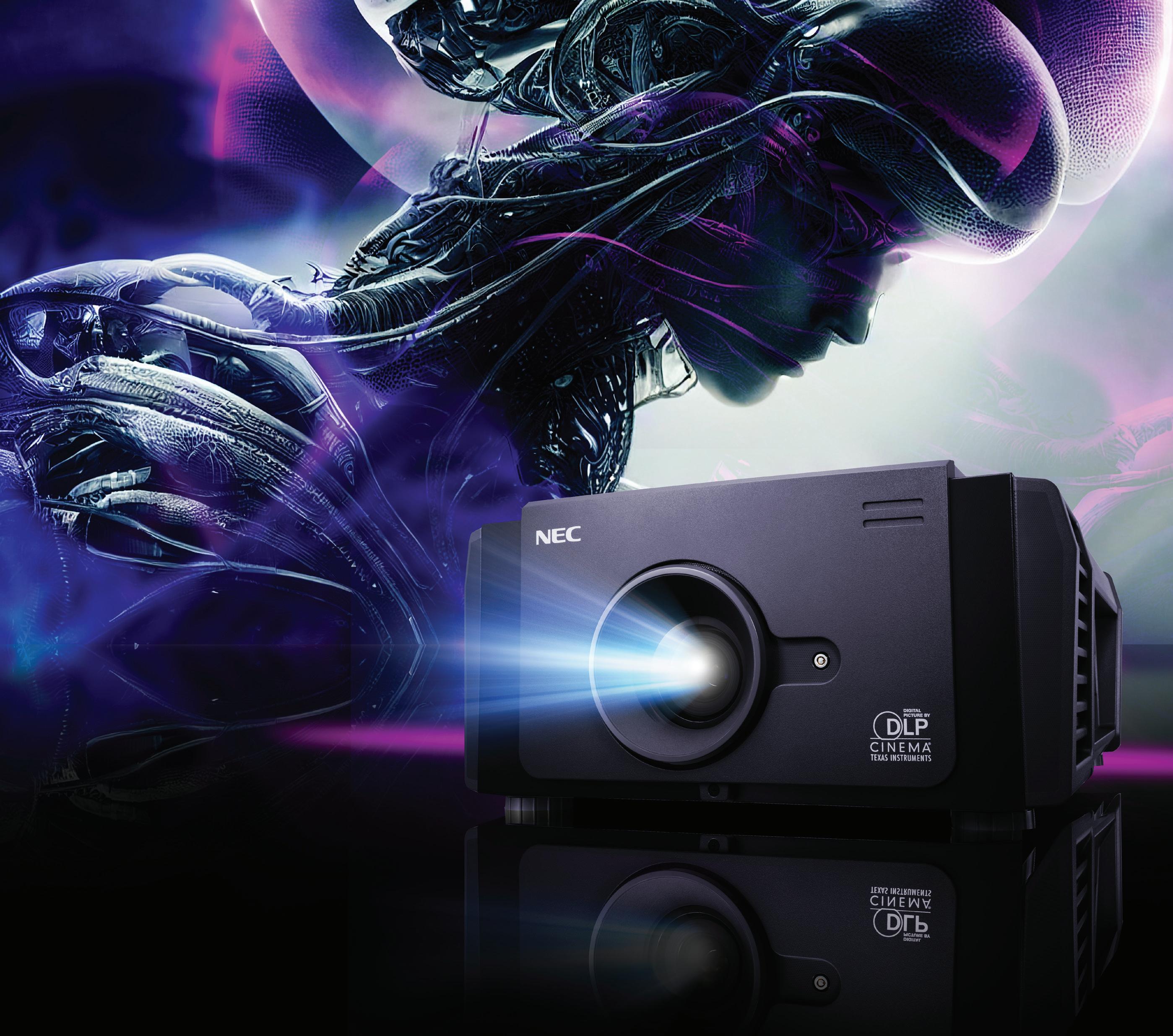
We also offer a safe, reliable refit, so you can simply replace older lamp-based projectors with a new energy efficient Sharp/NEC laser projector.
We also offer a safe, reliable refit, so you can simply replace older lamp-based projectors with a new energy efficient Sharp/NEC laser projector.
Visit sharpnecdisplays.eu
Visit sharpnecdisplays.eu
As moviegoers worldwide enthusiastically return to cinemas, premium theatrical options are increasingly in demand. Having spent nearly three years watching movies from home, consumers are craving an elevated experience only found in movie theaters!
 Nikki Daniel, Marketing Manager, D-BOX
Nikki Daniel, Marketing Manager, D-BOX
While more popular than ever, these enhanced formats that keep people coming back for more aren’t actually new. As a matter of fact, D-BOX—an immersive premium experience—is celebrating its 25th anniversary this year!
For nearly three decades, D-BOX has used haptic technology to bring movies to life through a unique combination of movement, vibration and texture hand-coded by haptic designers to synchronize perfectly with the onscreen action and sound. With over 65,000 haptic effects, movie-goers feel as if they are truly part of the movie, not just a passive observer. They can experience the action, excitement, thrills and drama first-hand, regardless of whether a movie features heavy duty explosions or superheroes swaying through the sky.
Based in Montreal, D-BOX launched its theatrical business on one screen in Los Angeles with the release of Fast and Furious in 2009. Fourteen years later, D-BOX has coded 2,500
films – including this year’s 10th installment of the Fast franchise – and are featured in over 500 theaters (820 screens) in 39 countries worldwide. This year alone over 60+ films will be coded more than any other premium format!
With 19,400 seats equipped globally, D-BOX is a leading supplier to top exhibitors including Cineplex (Canada), Cinemark USA, Cinemark International, Hoyts (Australia), Kinopolis (Germany), Cinesa and many more.
To ensure high-quality experiences, D-BOX’s haptic team works meticulously with film-makers and major studios, including Paramount Pictures, Sony Pictures, Universal Pictures, Walt Disney Pictures, Warner Bros. Pictures, Lionsgate and Studiocanal, as well as specialty companies like anime house Crunchyroll and various regional distributors in China, Germany, India, and more. Through these strategic and artistic partnerships and with the evolution of D-BOX’s technology, the haptic theatrical experience has comfortably exceeded initial expectations.
Started by a group of five individuals with a shared passion for music, D-BOX was named after ‘the box’ subwoofer speakers that the company first developed and commercialized. With clients such as Club Price (currently known as Costco) and other independents, the speaker’s launch was a clear success.
Inspired by the vibration created by the speakers’ bass when placed near a chair, the D-BOX team quickly set their sights on something bigger and bolder: cinema. To differentiate themselves and to avoid getting classified as just another speaker company, the D-BOX team realised this unique vibration and movement could add an extra dimension to the moviegoing experience.
They believed D-BOX technology could go beyond just entertaining the consumer, but also add a significant layer to the storytelling itself. Just as a movie’s audio track helps to

immerse people in the film, they knew their haptics could add an additional layer or immersion when synchronised with the action.
While the box speaker funded their research and development, the team began to build the first cinema prototype out of deconstructed printers. After nearly four years of trial and error, they finally had their very first deliverable in 2000: a one-size-fits-all platform that slid under seats and provided motion, ready to enhance the theatrical experience.
Shortly after they finished the first platform, D-BOX decided to hit the Canadian stock market and went public with an IPO they hoped would allow them to develop and commercialize more products. Extremely successful, the IPO brought in a $40 million CAD, which the team used to continue to innovate and improve their product offering.
With the IPO funds in the bank, D-BOX was able to assemble an even larger creative team. Collectively, these minds developed products similar to the current generation of technology: a signature haptic system comprised of actuators and cables.
As with any technology startup, there were still obstacles to overcome. As we all know, content is king, and D-BOX needed to provide a proof-of-concept with an actual feature film. This led to creating haptic tracks for their first two movies: The Terminator and Lost in Space.
Knowing that coding content was going to be a key factor in convincing potential clients to partner with them, the D-BOX team hired a team of haptic designers,all with backgrounds in music. These new designers helped to code new titles and to ensure haptics were perfectly synchronised to effects, including film scores, soundtracks, and on screen action. This ensured the motion was extremely realistic during any type of applicable scene, from a heavy-duty car chase to the gentle sway of a boat sailing over calm seas.
Fully equipped with a functional prototype, sufficient funding, and an experienced coding team, D-BOX took on the biggest challenge in what is now its 25 years of experience: securing enough quality Hollywood films to provide exhibitor partners with D-BOX-enabled content for 52 weeks a year.
Having flown around the world to demonstrate the fresh prototype for prospective partners and having demonstrated their technology at trade shows, Universal Pictures provided the opportunity for which D-BOX avidly searched: the greenlight to code Fast and Furious in 2009 for that one screen in Los Angeles. As they say, the rest is history.
19-22
JUNE 2023




CENTRE CONVENCIONS INTERNACIONAL BARCELONA (CCIB) CONVENTION & TRADE SHOW • CINEEUROPE.NET






OFFICIAL CORPORATE SPONSOR











































With growing success, D-BOX refused to limit itself to the theatrical industry. A burning desire to become a greater hybrid model led to the company branching out into five other business sectors: sim racing, professional simulation and training, gaming, home entertainment and attractions.
With world renowned partners in every applicable business sector, including Mercedes-Benz and Mercedes AMG, the FIA, John Deere, The United States Military, Ubisoft, Microsoft, Cooler Master, and many more, D-BOX has established itself as a world leader in haptic technology. They have a global reputation for providing the most realistic motion experience for every project, whether for entertainment or professional training purposes.
The Canadian company even recently came full circle: in partnership with RSEAT and Mercedes-Benz and Mercedes AMG with D-BOX releasing a haptic platform that can be seamlessly placed under any seat, sofa, or sim racing rig to provide an immersive entertainment experience to anyone, anywhere.

The company that started with a haptic platform and one coded movie is now recognized worldwide for its precision, quality, and passion. D-BOX is proud to celebrate its 25th anniversary with an all-new, Mercedes-branded platform and the release of every global tentpole film this summer and beyond.
D-BOX has coded over 2,500 films
What has undoubtedly contributed to D-BOX’s success is its people with every single person who comes through the doors leaving a positive impact on the company, contributing to revolutionising entertainment through haptics. Every role, every task, and every project continues to help to move the world of entertainment forward. It is these contributions that have enabled D-BOX to transition from speaker to platform, from platform to actuator, and from cinema to five other industries. With this experience, expanded technology, and a lineup of exciting potential partners in all sectors, the next 25 years look just as bright as the first 25, so who knows where they’ll move next.
D-BOX has featured in over 500 theatres - around 820 screens
Dr. Man-Nang Chong is the Founder, Chairman, and CEO of GDC Technology Limited. Whilst you may know him best in this role, he was actually an associate professor of the School of Computer Engineering at Nanyang Technological University, Singapore, from 1992 to 2000. In 1996, Dr. Chong led a team to win the “Worldwide Texas Instruments’ Digital Signal Processing Solutions Challenge” award with a digital motion picture restoration solution. With the prize money, he founded Nirvana Digital, a leading digital signal processing company, in 1999. The company was subsequently acquired by Acterna Incorporation in 2000. Shortly after this GDC Technology was born and the rest, as they say, is history.
As well as being a successful business leader, Dr Chong is passionate about the cinema industry and making sure our industry thrives at the cutting edge of technology; something that can only happen with talented engineers entering the business. Cinema Technology took some time to find out more about Dr. Chong’s passion for ‘paying it forwards’.

CT: Can you start by telling us a bit about the company?
Chong: First, thank you for this opportunity to share some thoughts with your readers. We are all fans of CT Magazine at GDC Technology and it is an honour to be part of this edition. At GDC,

we provide innovative products and services to help cinemas enhance the moviegoing experience for audiences around the world. We offer a comprehensive suite of products and services that enable cinema operators to deliver the highest quality moviegoing experience possible to their audiences. Many know GDC as a media server company. Over the last three years, we have become more than ‘just an IMB’ company with a comprehensive suite of enterprise software solutions and audio products.
CT: We recently became aware of the GDC Scholarship programme, tell me more and how you believe initiatives like this might help to address the skills shortage the industry currently faces and why education matters.
Dr Chong: I deeply believe in scholarships. In fact, I benefited from it myself. I actually studied in Scotland in the 1980s, specialising in electronics and later computer science and image processing. I did not come from a wealthy family without financial assistance. I would not have been able to complete my Ph.D. and achieve what I have achieved today and have contributed to the digital cinema industry without a scholarship. The scholarship program is granted to between 30 and 50 students every year. The scholarship in co-operation with the University of Science and Technology of China (USTC) is offered to undergraduate and postgraduate students from three USTC colleges: the School of Computer Science and Technology, the School of Information Science and Technology, and the School of Software Engineering. The scholarship is really a way to “repay society” for the help I was given decades prior. More than that, however, the GDC Scholarship is intended to encourage today’s engineers or engineers-to-be to think more about audio and video technology, especially when it comes to making and showcasing motion pictures.
We wanted to encourage bright engineers to think about what they can do for the cinema industry, not just apps or other technology. I think education is vitally important - it can change a person. Through the GDC Scholarship, we hope to motivate, encourage, and inspire future innovators to develop technology solutions exclusively for the cinema industry. We must continue to design and develop cost-effective solutions that entice exhibitors to invest in upgrading current locations and building new sites. If we don’t continue to innovate then there is a genuine risk that consumers will keep watching movies on their iPads, their phones, or their tablets.
CT: Finally, in terms of GDC technology innovations, what makes your current and new cinema solutions stand out from the competition?
Dr Chong: Our solutions are designed to provide the best possible moviegoing experience for audiences. For example, we let moviegoers SEE MORE with our media servers, and let them HEAR MORE with our latest range of audio solutions. Also we let exhibitors to ACHIEVE MORE with our enterprise software solution. Our software and cinema automation solutions are designed not only to help reduce operating expenses but also to allow the theatre’s management and staff to focus more on their customer service. Enhancements to the Enterprise Software Suite including the upcoming web-based TMS-2000WEB.
At CinemaCon 2023, GDC continued its reputation for launching several first-tomarket innovative products, such as PSD-SSD portable storage; compact, lightweight and available in models of 3TB, 4TB, and 6TB, it provides an excellent alternative to standard HDD options. The PSD-SSD can be easily mounted on DLP projectors, providing a convenient storage solution for professionals in the movie industry. GDC also showcased DIVE™ Dynamic Lighting System, a powerful and flexible LED control solution developed to program a themed single or multi-colour light show during the pre-show entertainment. Visitors also felt the sound of the SR-1000 IMB with the newly introduced built-in DTS® 7.1 ultimate surround sound with high-performance Japanese-made SATO Speakers, and a growing portfolio of audio solutions to streamline audio integration such as AE-6703, a 32-channel bi-directional converter bridging the worlds of AES3 and AES67, GDCs DAC Series of digital-analog converters, and remote Fader Control.
DTS 7.1 is a license feature available in the SR-1000 that utilises an optimized X-curve and state-of-the-art room tuning practices to deliver stunning sound quality and allows cinema operators the ability to promote their screens that feature the premium DTS brand. DTS 7.1 is a license feature available in the SR-1000 that utilises an optimized X-curve and state-of-the-art room tuning practices to deliver stunning sound quality and allows cinema operators the ability to promote their screens that feature the premium DTS brand. DTS 7.1 certified rooms feature all the core components of DTS:X installations and are easily upgradable to GDC featuring DTS:X for IAB immersive audio.
Immersive audio continues to grow, but cinema owners remain cautious about cost and installation logistics. GDC’s DTS:X Immersive Audio Solution is highly competitive and fully supports SMPTE’s ST 2098-2 immersive audio bitstream (IAB) standard delivering a single interoperable audio format for theatrical distribution. GDC DTS:X for IAB solution has flexible speaker configurations to enable installation in all auditoriums. It’s possible to retrofit theatres at a lower cost, saving up to 50% compared to other 3D sound systems.
AE-6703 AES3/AES67 32 x 32 Channel Bidirectional Converter
AE-6703 AES67 Converter provides the flexibility for cinema audio products to communicate seamlessly between the AES3 and AES67 worlds. It offers an audio interface between legacy AES3 audio equipment and the nextgeneration AES67 devices such as the cinema media server. The AE-6703 is a bidirectional converter capable of converting 32 channels of audio in each direction concurrently (total 64 channels processing).
Espedeo DAC Series Digital-to-Analog converter features 8, 12, 16, 24 and 32 channel configurations for analog output to meet your auditorium configuration needs.

AIB-3000 Digital-Analog Converter and Software License Enablement for DTS ® 7.1 Cinema Audio Processor
Later this year GDC Technology will launch the next-generation AIB-3000 audio interface box offering a 16-channel premium quality digital-analog converter. The AIB-3000 allows the remote switching of input sources via Ethernet. The versatile AIB-3000 is designed for media blocks with built-in 5.1 or 7.1 cinema audio processors, or operates independently as a 7.1 cinema audio processor with an audio software license.
Arcadia Cinemas
In the heart of Southern Europe, sits family owned and operated Arcadia Cinemas the operator of four cinemas in Northern Italy.
Sandie Caffelle talks to Laura Fumagalli, a second generation exhibitor and natural born cinematechnology enthusiast continuing to set trends in Italy with familyowned Arcadia Cinemas.

The Fumagalli family have been independent cinema exhibitors for over 40 years since Piero took over Cinema Centrale in Melzo in 1979. Arcadia Cinemas have always been the first in Italy to introduce cinema technology innovations, be it, in the very early days, Dolby Digital, DTS, SDDS at Centrale and furthermore at Arcadia.
“At Centrale, above all, I still remember the screening, in 1988, of Bernardo Bertolucci’s The Last Emperor in 70mm, with an on-site introduction by Academy Award winner cinematographer Vittorio Storaro and director Bernardo Bertolucci alongside, via a telephone connection, at that time”., Laura Explains.
Piero Fumagalli, founder of Arcadia, started as an exhibitor in 1979 at Cinema Centrale in Melzo (Milan). The company has grown to be one of the most successful independent operators in the country with cinemas in Melzo (Milan), Bellinzago Lombardo (Milan), Erbusco (Brescia) and Stezzano (Bergamo), all in the north of Italy.
Laura’s father Piero has a background in the music industry, with decades of experience organizing concerts and big live events, mainly in stadiums, for Italian and international singers alike.
The family opened ARCADIA Melzo, the first purpose built multiplex in Italy, on May 30th in 1997. Italy’s Vice Premier and Minister of Culture at that time, Walter Veltroni, cut the ribbon with Hitchcock’s “Vertigo” screening in 70mm. Vittorio Storaro collaborated closely with Arcadia on the overall project and on the choice of name of the cinema and screens. In ancient Greece, Arcadia was a valley where the natural elements found harmony. Aria, Acqua, Terra and Fuoco are in fact the names for the four twin halls, with 220 seats and 18 metres (60 feet) wide screens. George Lucas’ THX provided help in designing unique theatres as using acoustic and viewing parameters.
The 630-seats ENERGIA PLF screen has an impressive Harkness Perlux 1.8 gain, 30 meters (98 feet) wide screen with moving masking. The theatre is equipped with what is believed to be the largest Dolby Atmos™ configuration in the world of utilising a massive Meyer Sound™ audio system, similar to the system
installed at the Academy Museum in Los Angeles, CA.
In the booth there are 4 projectors: Christie Digital dual 4K laser projectors and two 70mm projectors, a Cinemeccanica Victoria 8 with platter system and a Philips DP70.
ARCADIA Melzo is the only commercial cinema in Italy equipped with 70mm/35m film projectors (one of less than twenty cinemas in Europe).
Cutting-edge technology has been at the heart of Centrale. At Arcadia, they introduced Digital Cinema as early as in 2001 showcasing their first digital movie, Disney’s “Atlantis: The Lost Empire”. The following year, in 2002, George Lucas’ s “Episode II - Attack of the Clones” was released. As a testament to the efforts made by Arcadia as an independent exhibitor, director George Lucas sent a personal video message praising Arcadia and greeting patrons among the very first audiences worldwide to experience Digital projection, the way he intended the movie to be seen.
Since 1997, ENERGIA PLF has been the reference screen for film enthusiasts in Italy who seek the very best theatrical experience.

“For us the key factors are the consistency of quality presentation over the decades, i.e. maintaining extremely high standards at all times and, also maintaining direct contact with our patrons, through various methods. This starts from welcoming them into an amazing atmosphere starting from the theatre lobby with a “life-size T-rex” replica and multiple “characters” from recent blockbusters. Uniquely, also in the theatre lobby, we host a permanent exhibition of cinema
technology including an Imax 15/70mm projector and the first prototype of Cinemeccanica 5/70mm projector”.
In 2017 the care, passion, attention to detail and dedication to innovation through technology shown by Piero Fumagalli were recognized by the International Union of Cinemas with the UNIC Achievement Award at CineEurope.
In the same year, the enormous investments made for the dramatic upgrade of the Energia PLF screen were awarded with the ICTA’s “Best Screen in Europe”.
Arcadia Stezzano is the most recent addition to the Arcadia cinema chain. Located within Le Due Torri Shopping Centre in Stezzano, (a few kms away from Bergamo), it opened in October 2021. The site consists of 7 screens, all Christie Cinelife Series 4 4K RGB laser projectors with UHC lenses, all recliner seats by

Cinearredo, creating a welcoming and elegant cinema space.

Melzo’s ENERGIA PLF has been replicated in Stezzano with two screens.
Slightly smaller in terms of capacity than the one in Melzo, due to recliner seats taking up more space, the technology features of the two ENERGIA PLF screens in Stezzano are the same as Melzo. To assure the superior and unique viewing experience offered by Arcadia, the Energia PLF screens offer huge screens, a large-scale high quality immersive audio system, the comfort of seats and beautiful public areas including entrances and waiting areas.
Beyond Stezzano, Arcadia has additional cinema sites, Arcadia Bellinzago Lombardo (Milano), a 10-screen cinema situated within La Corte Lombarda Shopping Center and Arcadia Erbusco (Brescia), a 6-screen complex within Le Porte Franche Shopping Center.
Having championed PLF experiences, Laura is convinced more than ever that PLF screens are the only true way to view content and fully appreciate the movie. “Filmmakers such as Nolan, Villeneuve, Cameron, Scorsese, Tarantino, Spielberg, Scott and Coppola are passionate about making films that should be seen with the best technology possible and fitting, at best, the screen size of PLF theatres worldwide. Arcadia has been doing just that on a day-to-day basis, passing that same passion for the theatrical experience both onto its staff and mostly onto different generations of audience members alike, it’s out our heart,” Laura explains.
“Being an independent family business gives us a 360-degree vision and understanding of the industry as a whole. It means working day after day, taking on the risks and seeing everything happening from all angles. Cinema is our lives – not just from a business standpoint but from a personal perspective too. Being able to do a job that one is so passionate about is simply a true privilege.
The Arcadia team are looking forward to showcasing Nolan’s Oppenheimer in 70mm national exclusivity in Italy, “We can’t wait, nothing is more important to us as an exhibitor than being “bearer of emotions”, being the trait-d’union between the creative mind of the director and the audience” concludes Laura.


hurt but we have to be even more thankful and humble that we made it through and particularly to the parts of the sector who weren’t able to streamline their income and expenditure in the way that perhaps some studios were able to, none more than the product manufacturers.
Caesars Palace, Las Vegas: 24
April – 27
April 2023
If you had been at CinemaCon five years ago you may have not noticed many differences this year. But for sure Everything is Everywhere different All at once since the past few years.
Last year there was a cautious approach. Against the backdrop of recovery from the pandemic it seemed only exhibition had faith in the sector. But my first take away this year was renewed optimism across the entire industry. Whilst last year a lot of studios were dancing around theatrical window discussion, this year there was broad consensus about the importance of windows with studios once again recognising that “...cinema exhibition is more important and vibrant than ever - we need you to continue. Thank you so much”. I wouldn’t have expected Vin Diesel to spread the most touching words of all. “Let’s skip the prompter…. I’m humbled. No one else other than you, my dear exhibitors believed for decades in my movies.”
It was quite refreshing to feel the positive vibes, to see lots of stars, much bigger film slates from all the studios and a much wider range of
entertainment. And talking of studios, those that the industry once saw as a threat - the streamers, in the guise of Apple and Amazon Studios are transitioning their movies to big screen theatrical releases (Napoleon, Killers of the Flower Moon as great examples). Why? Because, exhibition has once again proven that no other means can make more dramatic impact (financially and socially) on the success of a movie. As one executive noted, “no one else generates so many stars.” And this expanded slate will help the sector to recover back to pre-pandemic levels quicker. Will every movie appeal to audiences in different territories? Perhaps not, but every studio appears to have more R-rated content to get the right audience more frequently to the cinema. There is still a need for more family movies to get those audiences back but the enormous and continued success of Super Mario Bros. did showcase the importance of this market. But overall it felt like each studio did their job, more than ever to help put the industry back to where it should be.
Besides all positive waves, the biggest takeaway was that we’ve made it through the hardest times together. During the pandemic we all lost, and it
On giveaways, the goodie bags were filled with enough sweets to require dental treatment. The giveaways were a sign of what to expect in the trade show halls. From a technology perspective, there were less manufacturers than pre-Covid but perhaps a few more than last year. Of course consolidation has played its part but it clearly shows how dire things had become for the equipment suppliers through the pandemic. There were of course dozens of booths with diverse concession offerings for every moviegoers palate - perhaps a sign of the importance exhibitors are placing on the “experience” part.
Whilst concessions are important because they increase turnover, CinemaCon showcased the need for cinemas, particularly in North America, to have stability in terms of their operations. The big highs and lows in box office need to be smoothed out to ensure that the supply chain for equipment and concessions also stabilises. That of course comes down to the supply of movies, now it’s about making sure it continues for years and not just for a few months.
While many people were overwhelmed to see the industry booming again, there was a feeling that it was no time to rest but to get on with securing the future. There is a big amount of “homework” (out of home) which still must be done to secure audiences. Thousands of seats, projectors and auditoriums have to be refurbished or replaced, a legacy from work that would have happened before the pandemic. For sure, we also have a skills shortage that needs addressing with the sector having lost so many experienced staff. That was a big conversation piece and so many people asked how CTC could help the industry on that front - there are plan!


It’s great to see that there appears to be a lot of money to fix the shortages but apart from the excellent, exciting WIE (Women in Exhibition) program, there doesn’t yet seem to be enough action to address how to get new people into the industry. Likewise, it feels as though we need to address how to keep over-stretched staff in the sector, because we can’t afford to lose more skills or knowledge.
All the projector manufacturers presented their deep commitment to the industry. Christie, Cinionic and Sharp/NEC showed up with wider ranges and there appeared to be a lot of improvements particularly with lasers. Yes there are component and chip issues but there really is across the manufacturers, a projection solution for every cinema. The same applies to the other
big cinema brands such as Dolby, GDC and Harkness. These are companies that have struggled through the pandemic but have continued to innovate and create exciting products that can help improve the cinema experience. LED screen supporters such as MiT and Ballantyne Strong presented their news including flexible LED-Screen supports for most LED manufacturers. Acoustics and fit out experts Eomac continued to grow their acoustic treatment products and looking at these, it immediately reminded me of the importance of the work THX did and how some cinemas still have a long way to go in improving sound quality. But sadly across the show, I didn’t see that many new manufacturers entering the market, perhaps a sign of the size of the industry or the perceived risk in entering what those outside the sector would see as volatile and unstable. That was quite noticeable with LED screens. Despite there being more than 10 LED screen manufacturers with DCI approval, almost all were noticeably absent from view and in particular the trade show floors. Perhaps a sign that whilst LED screens may or may not be destined for cinema, they might be some years down the road. For sure the pandemic may have slowed that technology adoption down but the challenges remain, especially now. The high price tag, audio challenges, cost of install and lack of graded content might mean that outside of big showcase venues LED is still limited for a good five years.

Whilst the industry is transforming, it was absolutely great to be outside in the sun with giant Transformer statues on Wednesday’s outdoor party in the non-desert streets of Vegas. The event was a real highlight and everyone said how great it was to have more outside events taking advantage of great weather after spending so many hours in a black box every day - hopefully something that will be transferred in to CineEurope in June.

It felt as though the issues around making the sector more environmentally friendly didn’t reach CinemaCon strongly enough. There is a big focus in Europe around reducing the carbon footprint of cinema, less so at CinemaCon. That’s not to suggest the show itself hadn’t taken steps to reduce waste and use better products but in general it feels like the US needs to play catch up with the rest of the industry on carbon reduction. Whereas in the UK there was a two-day conference all about Greening the Big Screen, at CinemaCon it felt like there was a lack of new ideas or incentives to feature less waste.
Things were fractious going in to, during and after the pandemic but it felt like the whole industry was re-aligned again. It felt like the activities of the likes of CTC and Celluloid Junkie during and after the pandemic had played an important part in generating greater cohesion - the more we work together, the better the result will be!
My personal shout: The whole cinema industry has to continue to write more stories not just in movies. Like some of the international panelists explained “...we have to play more with the variety of our content and how to market the non-top ten movies”. In essence we have to be able to identify the dark horses and know how to back them to help them succeed. In a crowded and noisy world, just emails and notifications aren’t good enough any more, we must tell more stories in full concert mode.
Studios, distributors, manufacturers and operators have to align more closely. We need to leverage skills and creativity to do a better job of marketing movies and the industry. We need to identify the best pathways to moviegoers and divide and concur as a team. In short, know the movie-goer and who is most likely to inspire them through different platforms such as TikTok. As one executive said “creativity is not like a battery farm”. We all need to recharge, rethink and unite much more especially in a year when we have an incredible slate.

Cinema is back and the sector is buoyant, so let’s ride the wave. But we are still a complex industry with even more complex customers with differing needs. It’s not just about PLFs, it’s about end-toend premium experiences and premium service offerings for movie-goers. We need to use this platform of success to focus on securing a positive future. We need to work harder than ever to make the sector attractive for the next generation. We need more young, and in particular creative people in the industry to help drive ideas. From storytellers and script writers through to cinema designers and technology evangelists, we need more. Don’t wait on ChatGPT for ideas, they won’t come. Focus on content, focus on customer experiences, gather customer insights rather than customer data - rinse and repeat.
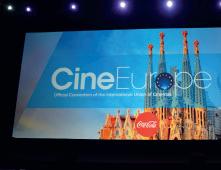
The big screen in the CCIB Auditorium.
will once again be held in the CCIB Auditorium. A collective team of Andy Peat Associates, Kelonik, MPS and a cast of others will once again deliver a state-of-the-art auditorium featuring the latest technology offerings from the likes of Cinionic, Harkness, RealD and KCS.
Barcelona, 19 - 22 June.
Back in Barcelona for the 11th time, Europe’s biggest movie convention CineEurope promises to be a huge success. The schedule looks to have a diverse feel to it with a mix of seminar sessions covering key business areas and current challenges, studio presentations and a trade show slowly regrowing after the pandemic. Although a convention with a strong steer behind content (which remains king), CineEurope continues to attract professionals from all areas of the international cinema industry.
CineEurope will once again provide a breadth of education content. Sessions will address the current skills shortage, how we attract talent to the industry, invest in that talent and how we retain staff for the longer term. Other sessions will focus around Audience Engagement and how we promote movies better to entice moviegoers back, sustainability and why it matters to movie-goers, sustainable cinema design, piracy and much more.
As CinemaCon proved, 2023 offers enormous excitement for movie-goers and studios will
once again deliver a series of slate presentations showcasing upcoming content. Confirmed to present are Unifrance & Creative Europe, Picturehouse Entertainment, Mubi, Sony Pictures, Studiocanal, Warner Bros, Walt Disney Studios, Universal Pictures and Focus Features, Paramount Pictures and Lionsgate.
All the major keynotes and slate presentations
Showing growth on 2022, the trade show once again splits between the main floor and suites on levels 1 and 2 and acts as an anchor to CineEurope offering exhibitors with the chance to meet with manufacturers of concessions and equipment, software suppliers, integrators, installers and architects. There’s lots of exciting new developments across the industry.
For the first time, CTC will be exhibiting on the tradeshow floor. You’ll be able to find us at Booth 226 (opposite PCO Group). You’ll also have an opportunity to meet our sponsors. Here’s where you’ll find them.
FLOOR +
FLOOR
FLOOR
You’ll be able to find updates from our non-exhibiting sponsors either via their web sites or by arranging a meeting with their representatives at the show. Arts Alliance Media (www.artsalliancemedia.com), MAG Audio (www.mag-audio.com), DX (www.dx.tech), RealD (www.reald.com), Audio Distribution Network (www.audionetwork.de) and Compeso (www.compeso.com).
AS we reach the end of the busy global trade show season, thoughts turn to the work required to ensure that the industry’s recovery is sustained and that against the backdrop of a strong slate we continue to demonstrate cinematic excellence to movie-goers around the world.
There is undoubtedly a skills shortage; a lasting effect from the pandemic and one that requires urgent attention. Education is key, particularly for those entering the industry and there are a number of initiatives underway many including CTCs direct involvement, all with a view of providing a range of educational deliverables to help fast track knowledge sharing. It comes as little surprise that as the industry rebuilds, more and more cinema professionals are flocking to CTC to support their learning.
and there are a number of initiatives underway many including
Over the past twelve months, CTCs membership has continued to grow rapidly and with strong global coverage. Our highly engaged global community now stands at over 850 members in more than 80 countries.
As well as our efforts to support the skills shortage, in recent months, the CTC team have been busy creating a range
CTC EXECUTIVE TEAM
Richard Mitchell (President), Graham Lodge (Vice President), Joseph Boutros, Mike Bradbury, Sandie Caffelle, Chris Connett, Mark Kendall, Peter Knight, Sarah Lewthwaite, Adam MacDonald, Saul Mahoney, Andre Mort, Markus Overath, David Pope, Toni Purvis, Ulf Qvicklund, Simon Tandy, Patrick von Sychowski, Kristina Warner, Paul Willmott
Behind everything that we do at the Cinema Technology Community is a passion for ensuring that moviegoers have the best cinema experience possible.


If you share that ambition, please join our community today by heading over to our site: cinema-technology.com
our highly respected Tech Talks seminars recently concluded with two presentations focused around laser projection and
capex requirements for laser projection
of digital deliverables focused around the technology and business challenges faced by exhibitors. The second series of our highly respected Tech Talks seminars recently concluded with two presentations focused around laser projection and laser speckle and we already have advanced plans in place for a third season of Tech Talks. We’ve also released a new white paper that takes an in-depth look at cinema screens and their ability to help improve presentation quality, lower opex costs, reduce carbon footprint and lower capex requirements for laser projection replacements. After a short hiatus, the podcast team reunited ahead of CineEurope for another episode of In The Pub with Mike Bradbury and they will be back together in July for another episode! Rest assured, as the industry rebuilds, we’ll be right by your side to help you and your teams learn and stay abreast of all things cinema and technology.
You can become a CTC member by visiting www.cinema-technology.com
www.cinema-technology.com


Greetings to all CT Magazine readers. We are delighted to announce that IMIS has completed the first phase of the restructure and invite you to explore our new website at www.movingimage society.net For the last two years the society has not taken subscriptions for membership. This was mainly due to the impact of the pandemic and our ability to deliver a program of networking events during this period. The board decided it was unreasonable to continue to take subscriptions without being able to deliver a service in return.
The good news is that the society’s membership of over 1,000 has been preserved over this time. All members should have recently received an email invitation of free access to the members area on the new website for a limited period. Just log-in using your email address. Check out all the new features and facilities we now offer. If we somehow missed you and you didn’t receive an email, please let us know by emailing membership@movingimagesociety.net
The society has faced some difficult times in recent years. More recently a small group of volunteer members have been working hard to stabilise finances, assets and infrastructure. The good news is - IMIS (formerly BKSTS) is now financially stable, still here and ready for re-launch and re-activation!
You probably already know the benefits of networking with colleagues from within your own specialism. In addition, IMIS presents you with the opportunity of networking with colleagues from outside your field of expertise. The increased
knowledge from presentations, meetings, events, and content from the full vista of the moving image industry, will surely help you to be even better at what you do. Consolidate and build on your position within these fast-moving industries. This basic philosophy has been at the core of IMIS for almost a century, and whatever your stage of career, it is more important now, than ever.
The new website will be developing and growing in content over the next year or two. In the members area:Please make an entry about yourself in the Members Directory so you can start increasing the size and breadth of your potential contacts.
Why not investigate some of the recordings of past events, or explore the portal that leads to our immense archive of articles and features about the moving image industries. You’ll find that our close association with Cinema Technology Magazine continues and all fully paid-up members will get printed copies posted to them.
Details of further events can be found including, introductions to virtual production and motion capture are being planned for later in the year.
The Society has always been a membership focused society. If you have any suggestions, can offer any assistance, or might want to get involved with the re-activation of The Society –wherever you are in the world, please get in contact with us by emailing: info@movingimagesociety.net
We are indebted to Pinewood Studios for their continued support of The Society as it re-activates. My thanks to Mark Trompeteler Chair of our Advisory Council for his assistance in writing this Newsletter.
On the heels of CinemaCon 2023, there is much to report on the many activities and upcoming events for the International Cinema Technology Association, so let’s jump right into it!
There was great enthusiasm and optimism in the air in Las Vegas for CinemaCon 2023. Attendance was noticeably up compared to recent years, nearly to “pre-pandemic” levels, and all of the studios showed full slates of very promising films for the remainder of this year and next. This year, ICTA sponsored its first-ever special educational seminar at CinemaCon, themed “The Fundamentals of Presentation Technology”, presented in partnership with NATO’s Cinema Foundation.
The 2-hour crash course was intended for cinema executives, owners, operators, and managers (and their staff) to acquaint non-technical personnel with the basic concepts of cinema audio, projection, networks, TMS and general maintenance of presentation technology. The intent of the course was to provide a foundation to allow these audiences to more easily converse with their technology providers and make more informed decisions on technology for their cinemas.”
The seminar was presented twice and both sessions were well attended. Subject matters included “Cinema Audio Technology” presented by Mark Mayfield, Q-SYS, “Cinema Projection and Media Technology”, presented by Reiner Doetzkies, Sharp/NEC, and “Networks, TMS, and Maintenance”, presented by Chase Taylor, Sound Vision Technical.
On the final morning of CinemaCon 2023, ICTA President Frank Tees kicked off another well-attended ICTA seminar entitled “Beyond the PLF: The Technology Behind Event Cinema and Live Events”.
In May, the ICTA participated in the annual cinema congress organized by the German cinema association, HDF Kino. ICTA Directors Oliver Pasch and Till Cussmann co-chaired a panel discussion on premium cinema strategies featuring Leonie Günther/Filmpalast Gruppe, Tobias Riehl/Paramount, HansJoachim Flebbe/Premium Kino, and Maximilian Hoffman/ Broadway Kino Ramstein.
ICTA will present its annual CineEurope Seminar Series with a half-day program at the Cinesa Cinema on Sunday, 18th June. Also on the schedule are the annual ICTA EMEA Cinema Awards. Exhibitors will be recognized in these categories:
All ICTA members are encouraged to join us in July for our annual Business Convention! This year, we will be in the heart of our beloved industry, Los Angeles, California, beginning July 22 through July 26, 2023. The 3-day agenda includes hot-topic business and technology sessions, panel discussions, tours of cutting-edge technology installations, and of course, plenty of time for networking.
A highlight of our programming this year is a special presentation by Ioan Allen, Dolby, of his renowned “Egg Show”. The Egg Show is an entertaining and evocative look at the influences of sound mixing on motion picture presentation.
www.ictaweb.com
Take a minute to visit our newly updated website at www.ictaweb.com. The site has many new features and resources, including registration links for our upcoming events.
CT: Please introduce yourself and tell us about your background?
I live near Saffron Walden in NW Essex on the boundaries with Cambridgeshire and Hertfordshire. I was brought up in Bristol but moved to Essex (via Staffordshire) when I went to Essex University in Colchester studying for an MSc in Electrical Engineering.
Most of my work prior to entering the cinema world was in IT. For many years I was a software engineer and then a software quality assurance contractor. This led me to working all over the UK in the electricity industry, assessing IT systems that were necessary for companies who wanted to become electricity suppliers when the market opened up in 1997.
CT: Tell us about your role with Saffron Screen and how it’s evolved?
Saffron Screen was set up in 2006 as a community-based cinema. The only suitable property the original directors could find was a share of an auditorium in the local county high school. This had the space and capacity but was limited by not having access during the day (in term time). Run by a small team supported by many volunteers, of which I was one, I volunteered as a projectionist just before the cinema opened.
Having volunteered as a projectionist I underwent a day’s training with the Picturehouse in Cambridge followed by working with a number of freelance projectionists over the next couple of months. The projection team expanded, adding another 5 or 6 volunteers which I trained on the 35mm equipment. After 6 months I was offered the paid position of Lead Projectionist and took this up whilst still continuing with
my IT contracts. But this proved difficult so I chose to focus on the projection role which was of much more interest to me.
In 2011 we raised funds to invest in digital equipment and I became the cinema’s technical manager. I project managed the upgrade to digital and trained all the volunteer projectionists. Over the next few years I instigated many improvements including going from 5.1 to 7.1 surround sound and automating the auditorium lights.
also looking to obtain our own premises (it’s been a long term aim), so I am always investigating new opportunities. I have a constant contact with our business manager which can cover all aspects of the business. One area that I still get hands-on with is the ticket system. Early on in the Saffron screen story we had a bespoke system developed by a local supporter of the cinema, but eventually this became too difficult to manage and improve so we moved to Veezi. I have maintained an interest in Veezi and regularly get involved with any issues our staff have (often resolving ticket and card payment issues).
In 2015 I became Business and Technical Manager overseeing other aspects of the business rather than just the technical areas and I continued in this role until I “retired” in 2017. At this point I was invited to join the Board as Technical Director. Saffron Screen is a registered charity and its trustees/board members are responsible for overseeing the operation of the cinema to ensure it is meeting its objectives. All trustee/board positions are unpaid roles. In 2018 I was elected as chair of the board which brings us up to the present day.

Every day is different! There are a number of administration tasks to take care of such as the one I am currently involved in which is to assist our financial director in producing the annual report. I still have an input into the technical side of the cinema, assisting our technical manager where requested. We are
CT: What are the biggest differences between a community cinema and a normal cinema in terms of how you deliver movies?
For us, the main difference is not specifically that we are a community cinema (I don’t really like that term as I don’t think it really reflects our setup), but it’s the fact that we are a single screen cinema that cannot open full-time. This restricts when we can show films – very few first run films, it’s usually 4-6 weeks off release dates. One advantage we do have, however, is that there is a high degree of integration with our customers. We have many individuals who would not consider going to a cinema on their own, but they will come to Saffron Screen because they will know all the staff and probably meet others they know who have come to see the film.
Also, we do not have a fixed area for a bar and refreshments which means we have to set up a temporary refreshment area which is in the auditorium. After many years we finally obtained an alcohol licence which pleased
“I instigated many improvements including going from 5.1 to 7.1 surround sound...”
many of our customers!
The biggest complaint we get is the quality of the seats. We have 202 seats which are on a raked system that can be retracted into the back wall when the school needs the space for exams. This means luxury recliners are never going to happen (another reason for wanting our own premises).

CT: How has the recovery been for Saffron Screen?
I cannot disguise the fact that we are suffering quite badly from the after effects of the pandemic. A combination of home streaming, lack of appropriate films and customers either still not confident of going to busy locations or have just got out of the habit of going to the cinema.
We are currently looking at alternative revenue streams but it is very difficult. I believe that there are many cinemas in a similar situation which is worrying.
CT: You’re involved in a number of industryrelated projects, can you tell us more about these?
I am one of the directors of the CTC which is a thoroughly rewarding opportunity to help cinemas deliver better movie-going experiences all over the world. My main
setups. The scheme has not been operating for the last few years, but along with my colleague Peter Knight, we have been working with the BFI to re-introduce this valuable technical support.
Over the past three years, the UKCA have been working on improving accessibility for customers. I have been on the team of technical experts looking at viewing subtitles through personally worn glasses to help with customers who have hearing difficulties. We are hopeful that this will come to fruition in the near future.
interest (and skill set) is with the smaller independent cinemas, but there is much that applies to all kinds of cinema, so not only can I provide my experience to CTC but I can learn from the outstanding talent in the organisation.
I have also been one of the BFI’s Technical Ambassadors, again focussing on improving sound and picture quality for smaller cinemas. This scheme allows organisations to obtain free assistance on issues they may have with their
CT: What’s your favourite thing about working in the industry?
One of the best things about working in the cinema industry as an exhibitor is the fact that everyone I meet from other cinemas is so helpful and willing to share their experiences. It is one of the reasons I like visiting other cinemas – I can gather so many ideas from how other organisations work. Likewise, I am very happy to help others (and I do get a lot of emails from other cinemas asking for advice)!
“...everyone I meet from other cinemas is so helpful and willing to share their experiences.”
Saffron Screen













































































